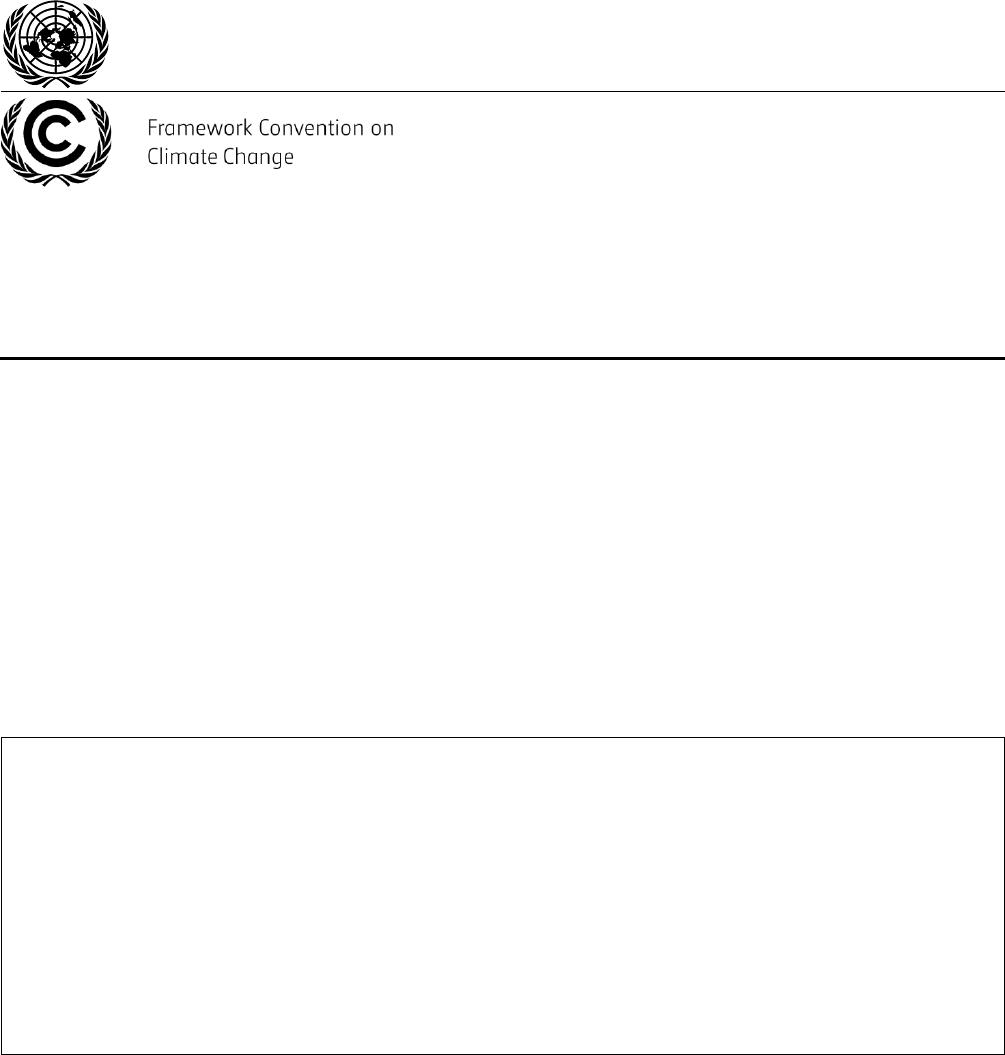SubsidiaryBodyforScientificandTechnologicalAdviceFifty-ninthsessionUnitedArabEmirates,30Novemberto6December2023SubsidiaryBodyforImplementationFifty-ninthsessionUnitedArabEmirates,30Novemberto6December2023TechnicaldialogueofthefirstglobalstocktakeSynthesisreportbytheco-facilitatorsonthetechnicaldialogueSummaryThissynthesisreportonthetechnicaldialogueofthefirstglobalstocktakeisbasedoninputsreceivedthroughouttheprocessanddiscussionsheldduringeachofthethreemeetingsofthetechnicaldialogueandservesasanoverarchingandfactualresourcethatprovidesacomprehensiveoverviewofdiscussionsheldduringthetechnicaldialogue,identifyingkeyareasforfurtheractiontobridgegapsandaddressingchallengesandbarriersintheimplementationoftheParisAgreement.Itprovidesanassessmentofthecollectiveprogresstowardsachievingthepurposeandlong-termgoalsoftheParisAgreementandinformsPartiesaboutpotentialareasforupdatingandenhancingtheiractionandsupport,aswellasforenhancinginternationalcooperationforclimateaction.UnitedNationsFCCC/SB/2023/9Distr.:General8September2023Original:EnglishADVANCEVERSIONFCCC/SB/2023/92ContentsPageAbbreviationsandacronyms............................................................................................................3I.Executivesummary..........................................................................................................................4A.Context.....................................................................................................................................4B.Mitigation,includingresponsemeasures.................................................................................5C.Adaptation,includinglossanddamage...................................................................................7D.Meansofimplementationandsupportandfinanceflows........................................................9E.Wayforward............................................................................................................................10II.Introduction......................................................................................................................................11A.Mandate...................................................................................................................................11B.Scopeofthereport...................................................................................................................12C.Possibleactionbythesubsidiarybodies..................................................................................12III.Summaryoftheprocessforthetechnicaldialogueofthefirstglobalstocktake.............................12IV.FindingsofthetechnicaldialogueonthefirstglobalstocktakeundertheParisAgreement...........13A.Context.....................................................................................................................................13B.Mitigation,includingresponsemeasures.................................................................................15C.Adaptation,includinglossanddamage...................................................................................23D.Meansofimplementationandsupportandfinanceflows........................................................32V.Wayforward.....................................................................................................................................39A.Goodpractices.........................................................................................................................39B.Informationgaps......................................................................................................................40C.Agreednextsteps.....................................................................................................................40AnnexesI.Traceableaccounts...........................................................................................................................42II.Approachtakentotheprocessofthetechnicaldialogueofthefirstglobalstocktake.....................44FCCC/SB/2023/93AbbreviationsandacronymsAFOLUagriculture,forestryandotherlanduseARAssessmentReportoftheIntergovernmentalPanelonClimateChangeBAbiennialassessmentandoverviewofclimatefinanceflowsBTRbiennialtransparencyreportCH4methaneCMAConferenceofthePartiesservingasthemeetingofthePartiestotheParisAgreementCO2carbondioxideCO2eqcarbondioxideequivalentCOPConferenceofthePartiesGEFGlobalEnvironmentFacilityGGAglobalgoalonadaptationGHGgreenhousegasGSTglobalstocktakeINDCintendednationallydeterminedcontributionIPCCIntergovernmentalPanelonClimateChangeLT-LEDSlong-termlow-emissiondevelopmentstrategy(ies)NAPnationaladaptationplanNDCnationallydeterminedcontributionREDD+reducingemissionsfromdeforestation;reducingemissionsfromforestdegradation;conservationofforestcarbonstocks;sustainablemanagementofforests;andenhancementofforestcarbonstocks(decision1/CP.16,para.70)SBsessionsofthesubsidiarybodiesSCFStandingCommitteeonFinanceSDGSustainableDevelopmentGoalTDtechnicaldialogueTransitionalCommitteetransitionalcommitteeontheoperationalizationofthenewfundingarrangementsforrespondingtolossanddamageandthefundestablishedinparagraph3ofdecisions2/CP.27and2/CMA.4TNAtechnologyneedsassessmentUNEPUnitedNationsEnvironmentProgrammeTD1.1,TD1.2andTD1.3refertospecificmeetingsofthetechnicaldialogueofthefirstglobalstocktake.FCCC/SB/2023/94I.ExecutivesummaryA.Context11.Keyfinding1:sinceitsadoption,theParisAgreementhasdrivennear-universalclimateactionbysettinggoalsandsendingsignalstotheworldregardingtheurgencyofrespondingtotheclimatecrisis.Whileactionisproceeding,muchmoreisneedednowonallfronts.2.ThereisbroadglobalcommitmenttotheParisAgreementanditscentralroleincatalysingthecooperativeactionneededtoaddresstheclimatecrisis,andithasinspiredsignificantprogressinglobalmitigationandadaptationactionandsupport.Againstforecastsmadepriortoitsadoption,theParisAgreementhasledtocontributionsthatsignificantlyreduceforecastsoffuturewarming,yettheworldisnotontracktomeetthelong-termgoalsoftheParisAgreement.ParticipantsintheTDofthefirstGSTnotedchallengesandbarriersacrossalltopicsdiscussedthereunder.Thediscussionsalsohighlightedexistingandemergingopportunitiesandcreativesolutionsforbridginggaps.Nowisthetimetorapidlyaccelerateactionandsupporttomakeprogressinthiscriticaldecade.3.Keyfinding2:tostrengthentheglobalresponsetothethreatofclimatechangeinthecontextofsustainabledevelopmentandeffortstoeradicatepoverty,governmentsneedtosupportsystemstransformationsthatmainstreamclimateresilienceandlowGHGemissionsdevelopment.Credible,accountableandtransparentactionsbynon-Partystakeholdersareneededtostrengtheneffortsforsystemstransformations.4.Acceleratingactiononclimatechangeiscrucialforachievingsustainabledevelopment.PoliciesandmeasuresthatpromoteclimateresilienceandlowGHGemissiondevelopmentcanbemademutuallysupportivethroughwhole-of-societyapproachesandintegrated,inclusivepolicymaking.ProgresshasbeenmadeundertheParisAgreementtowardspreparingandcommunicatingnewandupdatedNDCs.Effortstocontinuethisprogressmustbesustainedoverdecades,buildingonprogressmadeineverycycleofNDCsandintheGST.5.ClimateactionandsupportareenhancedbycatalysingactionbyallPartiesandnon-Partystakeholders,includingcivilsociety,theprivatesector,financialinstitutions,citiesandothersubnationalauthorities,localcommunitiesandIndigenousPeoples.Theimplementationofpledgesandactionsbynon-PartystakeholdersstrengthensParties’effortstosupportsystemstransformations.Rigorousaccountingandaccountabilityareneededtolendcredencetotheircontributions,trackprogresswithenvironmentalintegrityandavoiddoublecounting.Initiativesbynon-Partystakeholdersshouldalsoincludeandsupportstakeholdersandgroupsthatareoftenmarginalized,includingwomen,youthandIndigenousPeoples,sothateveryonecaneffectivelyparticipateinandcontributetotheseefforts.6.Keyfinding3:systemstransformationsopenupmanyopportunities,butrapidchangecanbedisruptive.Afocusoninclusionandequitycanincreaseambitioninclimateactionandsupport.7.Reachingnetzeroemissionsbyoraroundmid-centuryandimplementingconcurrenttransformativeadaptationrequiresbroadandrapidchangesinexistingpractices.Carefullydesignedclimateactioncangeneratesignificantbenefitsandcanhelptominimizedisruptionsbytakingawhole-of-societyapproachinformedbylocalcontext.EquityshouldenablegreaterambitionandincreasethelikelihoodofmeetingthegoalsoftheParisAgreement.Thosemostaffectedbyclimateimpactsshouldbeinvolvedincraftingsolutions.8.Formoreinformationonkeyfindings1–3,seechapterIV.Abelow.1Theheadingsinthisreportaresolelyintendedtoassistinnavigatingthedocument.FCCC/SB/2023/95B.Mitigation,includingresponsemeasures9.Keyfinding4:globalemissionsarenotinlinewithmodelledglobalmitigationpathwaysconsistentwiththetemperaturegoaloftheParisAgreement,andthereisarapidlynarrowingwindowtoraiseambitionandimplementexistingcommitmentsinordertolimitwarmingto1.5°Cabovepre-industriallevels.10.AllPartiestotheParisAgreementhavecommunicatedNDCsthatincludemitigationtargetsand/ormeasures.AgrowingnumberofPartieshavealsocommunicatedLT-LEDS.EmissionsgapsarethedifferencebetweentheemissionlevelsimpliedbytheNDCsandtheaverageemissionlevelsofglobalmodelledmitigationpathwaysconsistentwithlimitingwarmingto1.5°Cor2°C.Implementationgapsrefertohowfarcurrentlyenactedpoliciesandactionsfallshortofreachingstatedtargets.BasedoncurrentNDCs,thegaptoemissionsconsistentwithlimitingwarmingto1.5°Cin2030isestimatedtobe20.3–23.9GtCO2eq.211.ActionisneededtoincreaseboththemitigationambitionofNDCsandtheimplementationofmeasurestoachievetheirtargets.TrendsinhistoricalandongoingGHGemissionsprovideimportantinformationtounderstandthecurrentsituation,howitcametobe,andhowitcaninformfutureaction.12.AtCOP21inParis,PartiesagreedtoaimtoreachglobalpeakingofGHGemissionsassoonaspossible,recognizingthatpeakingwilltakelongerfordevelopingcountryParties.AccordingtotheIPCCAR6,globalGHGemissionsneedtopeakbetween2020and2025tolimitwarmingtotheParisAgreementtemperaturegoal.Emissionshavepeakedindevelopedandsomedevelopingcountries,butglobalemissionshavenotyetpeaked.AllPartiesneedtoundertakerapidanddeepreductionsinGHGemissionsinthedecadesafterpeaking.313.Keyfinding5:muchmoreambitioninactionandsupportisneededinimplementingdomesticmitigationmeasuresandsettingmoreambitioustargetsinNDCstorealizeexistingandemergingopportunitiesacrosscontexts,inordertoreduceglobalGHGemissionsby43percentby2030andfurtherby60percentby2035comparedwith2019levelsandreachnetzeroCO2emissionsby2050globally.14.Urgentactionandsupportareneededtorampupimplementationofdomesticmitigationmeasuresbyrealizingopportunitiesacrossallsectorsandsystems.Therearenowsufficientcost-effectiveopportunitiestoaddressthe2030emissionsgap,yetsignificantchallenges,includingaccesstoandavailabilityofsupport,remaininharnessingtheseopportunitiesattherequiredpaceandscale.Iffullyimplementedandsupported,realizingsuchopportunitiescanraiseambitiontosubstantiallyreducenetGHGemissionsby2030.Creativityandinnovationinpolicymakingandinternationalcooperationisessential.15.MoreambitiousmitigationtargetsinNDCsareneededtoreduceemissionsmorerapidly,andtoalignwitheachcountry’sLT-LEDStowardsjusttransitionstonetzeroemissionsbyoraround2050,whileenhancedtransparencycanhelptrackprogress.TheParisAgreementprovidesfortheprogression,includingbystatingtheexpectationthateachParty’ssuccessiveNDCswillrepresentitshighestpossibleambition,reflectingitscommonbutdifferentiatedresponsibilitiesandrespectivecapabilities,inthelightofdifferentnationalcircumstances,andwillbeinformedbytheoutcomesoftheGST.Progressionmayinvolve,amongotheroptions,morerapidreductionsthroughadoptingmorestringenttargetsandmorecomprehensiveformsoftargets.TheParisAgreementstipulatesthatdevelopedcountryPartiesshouldcontinuetakingtheleadbyundertakingabsoluteeconomy-wideemissionreductiontargetsandthatdevelopingcountryPartiesshouldcontinueenhancingtheirmitigationeffortsandareencouragedtomoveovertimetowardseconomy-wideemissionreductionorlimitationtargetsinthelightofdifferentnationalcircumstances.AsPartiesformulateandcommunicatetheirLT-LEDSthatchartjusttransitionstowardsnetzeroemissionsbyoraroundmid-century,tailoredtodifferentnationalcircumstances,theyshouldbegintoimplementconcretemeasurestoshifttosuchpathways.16.Mitigationmeasuresthatsuccessfullydeliveronothersustainabledevelopmentgoalscanbescaledupandreplicatedacrossdifferentcontexts.Thesustainable2FCCC/PA/CMA/2022/4.3Seeparas.97–98below.FCCC/SB/2023/96developmentbenefitsofimplementingmitigationmeasuresareveryimportantinbroadeninganddeepeningthesemeasures,inparticularwhentheyalsoaddresspovertyeradication.17.Keyfinding6:achievingnetzeroCO2andGHGemissionsrequiressystemstransformationsacrossallsectorsandcontexts,includingscalinguprenewableenergywhilephasingoutallunabatedfossilfuels,endingdeforestation,reducingnon-CO2emissionsandimplementingbothsupply-anddemand-sidemeasures.18.Whilethetimingofachievingnetzeroemissionswillvarybycountry,allcountriesneedtoadoptawhole-of-societyapproachtochartingpathwaystonetzeroCO2orGHGemissions.Manymitigationactionscanhaveco-benefitsandhelptoachieveSDGs.19.Scalinguprenewableenergyandphasingoutallunabatedfossilfuelsareindispensableelementsofjustenergytransitionstonetzeroemissions.Electrification,energyefficiencyanddemand-sidemanagement,aswellasenergystorage,arealsoimportantelementsinnetzeroenergysystems.420.Measurestoimplementsystemstransformationsinindustry,transport,buildingsandothersectorsmustrapidlyreduceprocessandenergyemissions.AmbitiousimplementationofmeasurestoaddressGHGemissionsfromindustry,transport,buildingsandothersectorscanreduceemissionsinthosesectorsandacrosstheirsupplychainswhilereducingcostsanddeliveringco-benefits.21.Haltingandreversingdeforestationanddegradationandimprovingagriculturalpracticesarecriticaltoreducingemissionsandconservingandenhancingcarbonsinks.Haltingandreversingdeforestationby2030andrestoringandprotectingnaturalecosystemswillresultinlarge-scaleCO2absorptionandco-benefits.Demand-sidemeasuresinagricultureandintensificationofsustainableagriculture,withoutfurtherlandexpansion,areessentialandcatalysewidespreadsustainabledevelopmentbenefits.22.Moreeffectiveinternationalcooperationandcredibleinitiativescancontributetobridgingemissionsandimplementationgaps.Arigorous“allofeconomy,allofsociety”approachisneededacrossallsystemsandsectors.Inaddition,moreeffectiveinternationalcooperationinvolvingnon-Partystakeholdersiscriticallyimportantinsupportingcountries’effortstoaccelerateprogress.23.Keyfinding7:justtransitionscansupportmorerobustandequitablemitigationoutcomes,withtailoredapproachesaddressingdifferentcontexts.24.Theconceptofequityiscomplexandmultidimensional.IndiscussionsatthefirstTD,diverseviewswereexpressedondimensionsofequityinmitigation.AcommonthreadwasthatequityshouldalignwithanupwardspiralofambitioninimplementingtheParisAgreement.525.Justtransitionprinciplescanbeadoptedandimplementedthroughcollectiveandparticipatorydecision-makingprocessestoreducethedisruptiveconsequencesofrapidsystemstransformations.26.Keyfinding8:economicdiversificationisakeystrategytoaddresstheimpactsofresponsemeasures,withvariousoptionsthatcanbeappliedindifferentcontexts.27.InformedapproachescanaddressnegativeimpactsofresponsemeasuresandpromotepositivesynergieswithinLT-LEDS,includingthrougheconomicdiversification.Economicdiversificationisoneofthestrategiestoaddressnegativeimpactsofresponsemeasuresandpromotepositivesynergies.Opportunitiesforsuchdiversificationincludegreenindustrialization,thegreeningofsupplychainsanddiversifyingtorelatedandunrelatedproducts.28.Formoreinformationonkeyfindings4–8,seechapterIV.Bbelow.4Seeparas.116–121below.5Seepara.132below.FCCC/SB/2023/97C.Adaptation,includinglossanddamage29.Keyfinding9:asclimatechangethreatensallcountries,communitiesandpeoplearoundtheworld,increasedadaptationactionaswellasenhancedeffortstoavert,minimizeandaddresslossanddamageareurgentlyneededtoreduceandrespondtoincreasingimpacts,particularlyforthosewhoareleastpreparedforchangeandleastabletorecoverfromdisasters.30.CollectiveprogressonadaptationandlossanddamagemustundergoastepchangeinfulfillingtheambitionsetoutintheParisAgreement.Thereisarapidlyclosingwindowofopportunitytosecurealiveableandsustainablefutureforall.Lossesanddamagestohumanandnaturalsystemshavealreadybeenobserved.Climateimpactsareerodingpasthumandevelopmentgainsand,withoutsufficientadaptationaction,willimpedetheabilitytomakesuchgainsinthefuture.Adaptationistheresponsibilityofallgovernments,atalllevels,yetcapacitytorecoverisunderminedbyrepeatedextremeclimateevents.31.Keyfinding10:collectively,thereisincreasingambitioninplansandcommitmentsforadaptationactionandsupport,butmostobservedadaptationeffortsarefragmented,incremental,sector-specificandunequallydistributedacrossregions.32.Adaptationplanningisthefirststepinaniterativecycletoenablemovingswiftlyfromunderstandingriskstomoreambitiousandeffectiveadaptationactionandsupport,theimplementationofwhichmustnowbeacceleratedtoincreaseadaptivecapacity,supportgreaterresiliencegainsandreducevulnerability.Partiesandnon-Partystakeholdersneedtoputinplacedurable,long-termreformsthatintegrateclimatechangerisksintoallaspectsofplanning,decision-makingandimplementation.Acrosstheadaptationcycle,progressisbeingmadeinmainstreamingclimate-relatedrisksindecision-making.However,sustainedandenhancedactionisneededtofullyimplementNAPsandplanningprocessesovertimetowardsimplementingdurablechangesthatreducerisksequitablyforthemostvulnerable.Eachiterationoftheadaptationcyclepresentsopportunitiestounderstandprogressandstrengtheneffortsonthebasisofexperience.Eachstageoftheadaptationcyclealsoprovidesopportunitiestorecognizetheeffortsofdevelopingcountriesinternationallyandtoexploreenhancedandacceleratedinternationalcooperationonadaptationaction.33.Transparentreportingonadaptationcanfacilitateandenhanceunderstanding,implementationandinternationalcooperation.Partieshavesubmittedadaptationcommunicationsasacomponentof,orinconjunctionwith,NAPs,NDCsornationalcommunicationsthatoutlinetheirexperienceandnationaleffortsinbuildingresilience,includingpriorities,implementation,andsupportneeds,plansandactions.Thereisextensiveactionandsupportonadaptationwellbeyondwhathasbeenreflectedinsubmittedadaptationcommunications.Partiesshouldconsiderreflectingtheirprogressinmainstreamingtheadaptationcycletoundertakemoreambitiousadaptationactionswhenperiodicallyupdatingthesecommunications.WorkonNAPsisproceedingandmanygovernmentsaremainstreamingadaptationandresilienceintheirNAPsandplanningprocesses.IncomparisonwithpreviousNDCs,moreoftheNDCssubmittedin2022containedadaptationinformation,andPartiesareabletoalsovoluntarilyincludeinformationonclimateimpactsandadaptationprogressinBTRs.34.DiversemethodologiesandindicatorscanbedrawnupontoinformtheunderstandingofprogresstowardstheGGA.Theircontinueddevelopmentisessentialtomonitoringandevaluatingeffortsacrossadaptationplanningandimplementation.IndrawingonthesedevelopmentsanddefiningtheframeworkoftheGGA,amorecomprehensiveassessmentofcollectiveprogresstowardstheGGAshouldbepossibleduringthesecondGST.35.Adaptationeffortsbydevelopingcountriesarebeingrecognizedandwillreceivefurtherrecognitionduringhigh-leveleventsatCMA5.TheadaptationeffortsofdevelopingcountryPartieshavebeenrecognizedinvariousways.66Seepara.150below.FCCC/SB/2023/9836.Keyfinding11:whenadaptationisinformedanddrivenbylocalcontexts,populationsandpriorities,boththeadequacyandtheeffectivenessofadaptationactionandsupportareenhanced,andthiscanalsopromotetransformationaladaptation.37.Transformationalapproachestoadaptationgeneratenewoptionsforadaptingtotheimpactsandrisksofclimatechangebychangingthefundamentalattributesofsystems.38.Thereareopportunitiesforadaptationacrosssystemsandsectors,manyofwhichhavebeenmainstreamedintoexistingdevelopmentprioritiesandprocesses.Goodpracticesarewelldocumentedacrossawiderangeofsectorsandthemes,addressingawiderangeofhazards,andareavailabletohelpguideadaptationaction(seefigure2).Thescientificliteraturepointstovariousadaptationoptionsandgoodpracticesforadaptingtospecifichazardsrelatedtoclimatechange,aswellasoptionsforinternationalcooperation.739.Afundamentalstartingpointforenhancedadaptationactionisthedisseminationofclimateinformationthroughclimateservicestomeetlocalneedsandpriorities.Suchclimateservicesprovideactionableclimateinformationandpredictionstoinformpolicieson,planningofandimplementationofadaptationaction.Theseservicesimproveresponsestoprojectedrisksandscenarios,promotesocialinclusionandavoidshiftingriskstootheractorsorreinforcingexistingvulnerabilities.840.Internationalcooperationcanhelpshareexperiencesinrealizingopportunitiesandovercomingbarrierstoandchallengesintheimplementationofadaptationplansandpromotelearningfromgoodpracticesacrossvariouscontexts.Internationalcooperationandinitiatives,includingamongnon-Partystakeholdersworkingonadaptation,canenhanceandsupportsystemstransformationsinvolvingcommunities,localauthorities,civilsocietyandbusinesses.Partnershipswithtraditionallymarginalizedgroups,includingwomen,youth,IndigenousPeoplesandlocalcommunities,andethnicandotherminoritygroups,arevitallyimportant.41.Keyfinding12:averting,minimizingandaddressinglossanddamagerequiresurgentactionacrossclimateanddevelopmentpoliciestomanageriskscomprehensivelyandprovidesupporttoimpactedcommunities.42.LimitingwarmingtotheParisAgreementglobaltemperaturegoalwouldsignificantlyreducetherisksandimpactsofclimatechangecomparedwithhigherwarminglevels.Impactswillincreaseforeveryfractionofadegreeofglobalwarming.Projectedimpactswillexceedhardlimitstoadaptation,primarilyinnaturalsystems.Someimpactswillbeirreversibleastemperaturesincreasebeyond1.5°C.Greaterunderstandingisneededofhowtoavoidandrespondtotippingpointsandmoreknowledge,understanding,support,policyandactionareneededtocomprehensivelymanagerisksandavert,minimizeandaddresslossanddamage.43.Keyfinding13:supportforadaptationandfundingarrangementsforaverting,minimizingandaddressinglossanddamageneedtoberapidlyscaledupfromexpandedandinnovativesources,andfinancialflowsneedtobemadeconsistentwithclimate-resilientdevelopmenttomeeturgentandincreasingneeds.44.Assessmentofcollectiveprogressonadaptationhasrevealedanurgentneedtorapidlyscaleupfinanceforadaptation,tomeetthegrowingneedsandprioritiesofdevelopingcountries.945.Inconsideringtheconsistencyoffinanceflowswithclimateresilientdevelopmentandshiftingawayfromactionsthatleadtomaladaptation,theamountandeffectivenessoffundinggoingtoadaptationneedsongoingattention.1046.Formoreinformationonkeyfindings9–13,seechapterIV.Cbelow.7Seepara.156below.8Seeparas.157–161below.9Seepara.I.D.48488below.10Seepara.522below.FCCC/SB/2023/99D.Meansofimplementationandsupportandfinanceflows47.TheParisAgreementrecognizesfinance,technologyandcapacity-buildingunderitsArticles9,10and11respectivelyascriticalleversofenablingclimateaction.ItfurtherrecognizesinArticle2,paragraph1(c),thatmakingfinancialflowsconsistentwithapathwaytowardslowGHGemissionsandclimate-resilientdevelopmentwillalsobecritical.Scalingupclimateambitionalsorequirestransformingtheinternationalfinancialsystem.48.Keyfinding14:scaled-upmobilizationofsupportforclimateactionindevelopingcountriesentailsstrategicallydeployinginternationalpublicfinance,whichremainsaprimeenablerforaction,andcontinuingtoenhanceeffectiveness,includingaccess,ownershipandimpacts.49.Rapidlyscalingupthemobilizationofsupportforclimateactionindevelopingcountriesisnecessarytomeeturgentneeds.ClimatefinancefromdevelopedtodevelopingcountrieshasincreasedsincetheadoptionoftheParisAgreement.Severalreportspointtotheincreasesandshortfallsinthemobilizationandprovisionofsuchfinance.11Acceleratedactionisrequiredtoscaleupclimatefinancefromawidevarietyofsources,instrumentsandchannels,notingthesignificantroleofpublicfunds.Publicfinancealoneisnotsufficienttoaddressthegapbetweenfinancingneedsandcurrentfinanceflows,particularlyindevelopingcountries.Whileremainingsmaller,theshareofadaptationinmobilizedclimatefinanceincreased–from20percentin2017–2018to28percentin2019–2020–andgrewatahigherratethanmitigationfinance.50.Accesstoclimatefinanceindevelopingcountriesneedstobeenhanced.Simplifiedandimprovedaccesstoclimatefinancecanallowforthemorerapiddeploymentofurgentlyneededfinancewhilealsobetterservinglocalneeds.Multilateraldevelopmentbanksandotherinternationalfinancialinstitutionshavepotentialtoevolveandstrengthentheirroles,mitigatefinancialrisks,lowerinvestmentcosts,enhanceaccesstofinanceandaddressdebtsustainability.51.Directingclimatefinancetowardsmeaningfulactivitiesandcontinuingtostrengthenmonitoring,evaluation,andlearningcanmoreeffectivelymeetneeds,particularlyindevelopingcountries.Enhancingandtrackingtheeffectivenessofclimatefinanceacrossaspectsofaccess,ownershipandimpactareimportantconsiderationsinmakingprogresstowardsmeetingsupportneedsanddeliveringdesiredoutcomes.52.Keyfinding15:makingfinancialflows–internationalanddomestic,publicandprivate–consistentwithapathwaytowardslowGHGemissionsandclimate-resilientdevelopmententailscreatingopportunitiestounlocktrillionsofdollarsandshiftinvestmentstoclimateactionacrossscales.53.Effortsmustbepursuedonallfrontstowardsmeetinginvestmentneeds,includingbymakingfinancialflowsconsistentwithapathwaytowardslowGHGemissionsandclimate-resilientdevelopment.Whilepublicfinancemaybedeployedtoincentivizehigh-impactinvestmentsandtocrowd-inprivatesectorfinance,globalanddomesticcapitalmarketsarelikelytobetheprimarysourceofcapitalforscalingupmitigationandadaptation.Whilepublicfinancewillcontinuetohaveakeyroletoplayinfinancingadaptation,increasedprivatesectorengagementisneededtomakefinancialflowsconsistentwithclimate-resilientdevelopment.54.Opportunitiesforfinancingmitigationandadaptationcanbeenhancedbyenablingconditionsandovercomingconstraints.Thepolicyandbroaderenablingenvironment,aswellastheavailabilityofeffectiveinstrumentsforde-riskinginvestmentsandcreatingpipelinesofinvestableproductsforadaptationandmitigation,presentanimportantopportunityfordeliveringfinanceatthescaleneeded.Furtheractionsarerequiredtomitigaterisks,lowerinvestmentcosts,andenhanceaccess.55.Itisessentialtounlockandredeploytrillionsofdollarstomeetglobalinvestmentneeds,includingbyrapidlyshiftingfinanceflowsgloballytosupportapathwaytowardslowGHGemissionsandclimate-resilientdevelopment.Significantfinanceflowscontinue11Seeparas.183–185below.FCCC/SB/2023/910beingdirected,includingthroughsubsidies,towardsinvestmentsinhigh-emissionsactivitiesandinfrastructurethatlackresilience.ShiftingtheseflowsiscriticaltomakingrapidanddurableprogresstowardsachievingtheParisAgreementgoals.56.Asystematicapproachtoshiftingfinanceflowsisneededtosupporteffectiveclimateactionattherequiredscaleandspeed.ThescaleofinvestmentsrequiredtoachievethegoalsoftheParisAgreementhighlightstheneedtotransformthefinancialsystemanditsstructuresandprocesses,aswellmaximizetheeffectivenessofinternationalcooperativeinitiativesonclimatefinance.57.Keyfinding16:existingcleanertechnologiesneedtoberapidlydeployed,togetherwithacceleratedinnovation,developmentandtransferofnewtechnologies,tosupporttheneedsofdevelopingcountries.58.MoreeffectiveandstrategicinternationalcooperationontechnologydevelopmentandtransferandinnovationwouldenablerapidsystemstransformationsthatarealignedwithachievingthegoalsoftheParisAgreement.Intensiveeffortstosupportcooperationandinnovationareessentialthroughoutthetechnologycycleandacrossallsectorsandlocations.Reductionsincostsandincreasedaccesstofinanceforsomekeytechnologiesshouldenablegreaterdeploymentinallgeographicareas,particularlyindevelopingcountries.ContinuingtodrivedowntheaveragecostofcapitalforsuchtechnologiesandreducingunitcostsforotherkeytechnologiesforjustenergyandothersectoraltransitionswillbedecidingfactorsforwhetherthegoalsoftheParisAgreementaremet.Strongerenablingenvironmentswillbeneeded,ensuringinclusivemulti-stakeholderengagementandaccesstofinancialsupportandcapacity-building.59.Collaborativeapproachestoclimatetechnologyresearch,developmentanddemonstrationarecrucialfordeployingmatureclimatetechnologiesanddevelopingemergingtechnologiesonalargescale.Suchapproachescanincludeinvestmentsintechnologydevelopmentandtransferthroughjointresearchanddevelopmentprogrammesandcapacity-building.ResearchanddevelopmentrequiredtoachievenetzeroCO2emissionsby2050,particularlyin“hardtoabate”sectors,isvital.Researchisalsoneededtounderstandtheroleoftechnologyandinnovationinsupportingtransformationaladaptation.60.Keyfinding17:capacity-buildingisfoundationaltoachievingbroad-rangingandsustainedclimateactionandrequireseffectivecountry-ledandneeds-basedcooperationtoensurecapacitiesareenhancedandretainedovertimeatalllevels.61.Capacitylimitationspresentbarriersacrossalldimensionsofclimatepolicy,includingmitigation,adaptation,enablingandusingtechnologyandfinance,andaverting,minimizingandaddressinglossanddamage.Tobeeffective,capacity-buildingneedstobesystemicbyinvestingintheexistingunderlyingsocialandeconomicsystems.Capacities,includingskilledhumanandinstitutionalcapacities,needtoberetainedovertime.62.Strategiccapacity-buildingsupporttodevelopingcountriesneedstobescaleduptoaddresslocallydeterminedneeds,includingonthebasisofIndigenousandothertraditionalknowledgesystems.Makinginternationalcooperationoncapacity-buildingmoreeffectiveandimpactfuliskey.Greatercoherenceandcoordinationofsupport,includingacrosstheUnitedNationssystem,willhelptoensurethatneedsarebeingmetandwillenhanceeffectiveness.63.Formoreinformationonkeyfindings14–17,seechapterIV.Dbelow.E.Wayforward64.ThefirstTDhasbeenbasedonthebestavailablescience,drawingonthefindingsoftheAR6andotherknowledgesources,withextensiveinvolvementofexperts.DuringtheTDitbecameclearthatmanyactionablesolutionsandcreativesuggestionstoovercomechallengesidentifiedduringtheinputandtechnicalphasesoftheGSTarereadytobeimplemented.InformationgapsalsoemergedthatthescientificcommunitymightaddressintheyearsaheadinordertobetterinformthenextGSTandworkprogrammesandotherprocessesundertheParisAgreement.TheinformationgeneratedfromthefirstGSTcanFCCC/SB/2023/911informongoingprocessesandworkprogrammesundertheParisAgreement,andthoseeffortscaninturninformassessmentsofcollectiveprogressunderfutureGSTs.AsPartiespreparetheirnextNDCs,theymaydrawontherichtechnicalinformationdrawnfromtheinputandtechnicalassessmentphasesofthefirstGST.65.ThefirstGSTistakingplacewithinaneraofdramaticandwidespreadchanges.Sinceitsadoption,theParisAgreementhasinspirednear-universalclimateaction,yettheglobalcommunityisnotontracktowardsachievingthelong-termgoalsoftheParisAgreement,despiteprogressmade.TheParisAgreement,throughitsdesignandtheGST,providesthebasisforfurtherambitioninenhancingactionandsupporttorespondtotheclimatecrisis.ThefirstGSTcomesatacriticalmomentforacceleratingcollectiveprogress.Asthetechnicalfindingspresentedinthisreportshow,muchmoreaction,onallfrontsandbyallactors,isneedednowtomeetthelong-termgoalsoftheParisAgreement.66.Formoreinformation,seechapterVbelow.[Englishonly]II.IntroductionA.Mandate67.Article14oftheParisAgreementprovidesthattheCMAshallperiodicallytakestockoftheimplementationoftheParisAgreementtoassesscollectiveprogresstowardsachievingitspurposeandlong-termgoals,referredtoastheGST,anddecision19/CMA.1laidoutthemodalitiesandsourcesofinputoftheGST,includingthattheGSTwillbeconductedwiththeassistanceofthesubsidiarybodies.12CMA3welcomedthestartofthefirstGST,13andtheconsiderationofoutputswilltakeplaceatCMA5.68.TheTDfacilitatedexpertconsiderationofinputsfromthesourcesidentifiedfortheGST.14CMA115decidedtheTDwould:(a)Undertakeitsworkthroughafocusedexchangeofviews,informationandideasinin-sessionroundtables,workshopsorotheractivities;(b)OrganizeitsworkinlinewithtakingstockoftheimplementationoftheParisAgreementtoassessthecollectiveprogresstowardsachievingitspurposeandlong-termgoals,includingunderArticle2,paragraph1(a–c),inthethematicareasofmitigation,adaptationandmeansofimplementationandsupport,noting,inthiscontext,thattheGSTmaytakeintoaccount,asappropriate,effortsrelatedtoitsworkthat:(i)Addressthesocialandeconomicconsequencesandimpactsofresponsemeasures;(ii)Avert,minimizeandaddresslossanddamageassociatedwiththeadverseeffectsofclimatechange;(c)Befacilitatedbytwoco-facilitators,whowillberesponsibleforconductingthedialogueandforpreparingafactualsynthesisreportandotheroutputsofthetechnicalassessment,withtheassistanceofthesecretariat.69.PriortothestartofthefirstTD,theChairsofthesubsidiarybodies:(a)Preparedanon-paperand,afterconsultingwithParties,revisedit,16aimingtoassistPartiesandnon-PartystakeholdersinpreparingforthefirstGST,andincludingguidingquestionsfortheinformationcollectionandpreparationcomponentofthefirstGST;(b)IssuedacallforinputsforthefirstGST;12Decision19/CMA.1,para.4.13Decision1/CMA.3,para.76.14Seedecision19/CMA.1,paras.36–37.15Decision19/CMA.1,para.6.16Availableathttps://unfccc.int/documents/274746.FCCC/SB/2023/912(c)PreparedguidingquestionsforthetechnicalassessmentcomponentofthefirstGSTandrevisedthem17onthebasisoftheviewsexpressedbyPartiesonthismatteratinformalconsultationsheldinOctober2021.B.Scopeofthereport70.Thissynthesisreporthasbeenpreparedbytheco-facilitatorsonthebasisoftheinputsreceivedthroughoutthetechnicalassessmentandthediscussionsheldduringeachofthethreemeetingsoftheTD.ThereportprovidesacomprehensiveoverviewofthediscussionsheldduringtheTDandidentifieskeyareasforfurtheractiontoaddresschallengesintheimplementationoftheParisAgreement.Itprovidesinsightsintocollectiveprogresstowardsachievingthepurposeandlong-termgoalsoftheParisAgreementandinformsPartiesaboutpotentialareasforupdatingandenhancingtheiractionandsupport,aswellasforenhancinginternationalcooperationforclimateaction.C.Possibleactionbythesubsidiarybodies71.ThesubsidiarybodiesmaywishtoconsiderthisreportaspartoftheirdeliberationsontheconclusionofthefirstGST.III.Summaryoftheprocessforthetechnicaldialogueofthefirstglobalstocktake72.AspartofthetechnicalassessmentcomponentofthefirstGST,threemeetingsoftheTDwereheldinconjunctionwithSB56,SB57andSB58,andasummaryreportoneachmeetingwaspreparedbytheco-facilitators.18BuildingontheapproachtakenatTD1.1andadoptingalearning-by-doingapproach,theTDservedtofacilitatetheexpertconsiderationofinputsintotheGSTthroughfocusedexchangesofviews,informationandideasatin-sessionroundtables,workshopsandotherrelevantactivities.73.TheworkoftheTDwasorganizedinthethematicareasofmitigation,adaptation,andmeansofimplementationandsupport.ThefindingsonthetopicspresentedinchapterIVbelowhavenohierarchy,andthenumberingandwordingofsubchaptersaresolelyusedforeaseofreference.TheTDconsideredeffortsrelatedtothesocialandeconomicconsequencesandimpactsofresponsemeasuresandtoaverting,minimizingandaddressinglossanddamageassociatedwiththeadverseeffectsofclimatechange(seeannexIforabetterunderstandingofthesourcesofspecificinformationusedinpreparingkeyfindingsandsupportinginformation).TheTDwasaParty-drivenprocess,withobserverorganizationsandothernon-Partystakeholdersparticipating(seeannexIIfordetailsontheapproachtakentotheTD).74.ThearcofdiscussionsduringtheTDincludedlayingtheinformationbase,includingonwell-knowngapsandonwhatisbeingdoneatTD1.1andidentifyinghowtobridgegapsandshiftthefocustoimplementationatTD1.2,andconcludedwithfocuseddiscussionsonnextsteps,includinghowPartiesandnon-PartystakeholderscouldmakefurtherprogressintheircollectiveeffortstowardsachievingtheParisAgreementgoalsatTD1.3.17Availableathttps://unfccc.int/sites/default/files/resource/Draft%20GST1_TA%20Guiding%20Questions.pdf.18Availableathttps://unfccc.int/topics/global-stocktake/components-of-the-gst/technical-dialogue-of-the-first-global-stocktake#Relevant-documents.FCCC/SB/2023/913IV.FindingsofthetechnicaldialogueonthefirstglobalstocktakeundertheParisAgreementA.Context75.Keyfinding1:sinceitsadoption,theParisAgreementhasdrivennear-universalclimateactionbysettinggoalsandsendingsignalstotheworldregardingtheurgencyofrespondingtotheclimatecrisis.Whileactionisproceeding,muchmoreisneedednowonallfronts.76.TherapidentryintoforceoftheParisAgreementin2016demonstratedbroadglobalcommitmenttoitspurpose.Sinceitsadoption,PartieshaveadoptedpoliciesandtakenactionalignedwiththegoalsoftheParisAgreement.WhilePartiesaremakingprogressinimplementation,theglobalcommunityisnotyetontracktomeetthelong-termgoalsoftheParisAgreement.77.However,significantprogresshasbeenmadesincetheentryintoforceoftheConventionalmost30yearsago,asevidencedbythesignificantshiftsinprojectionsofglobaltemperatureincreasein2100.AttheadoptionoftheCancunAgreementsin2010theexpectedglobaltemperatureincreasein2100was3.7–4.8°C.19In2015,withtheadoptionoftheParisAgreementandcommitmentsmadethroughINDCs,theexpectedglobaltemperatureincreasereducedto3.0–3.2°C.2078.FurtherprogresswasmadeundertheParisAgreement,asupdatedNDCsandlong-termplanswereannounced.ByCOP26aglobaltemperatureincreaseof2.6–2.7°Cwasexpectedin2100.21TheGlasgowClimatePacturgedPartiesthathadnotyetcommunicatedneworupdatedNDCstodosoassoonaspossibleandtorevisitandstrengthentheir2030targetstoalignwiththeglobaltemperaturegoal.AnnouncementsatCOP27indicatedexpectedtemperatureswerereducedfurtherto2.4–2.6°Cwiththepossibilityofreaching1.7–2.1°Cwhentakingintoaccountthefullimplementationoflong-termnetzerotargets.2279.AftersixIPCCassessmentcycles,globalawarenessoftheimpactsofclimatechangehasneverbeenhigherandtheneedforintegratingclimateadaptationintodecision-makinghasneverbeenclearer.Supportandfinanceforclimateactionhaveincreasedsignificantlyinthepastdecade,andthegrowingawarenessoftherisksofclimatechangehaveledtosignificanteffortstoscaleupsupportforclimateactionindevelopingcountries.ThroughtheGSTprocess,137non-PartystakeholdershavesubmittedinformationontheiractionstosupportthegoalsoftheParisAgreement.Atthisearlystage,theParisAgreementhasenhancedeffortsconcerningclimatechangemitigationandadaptationandfacilitatedtheprovisionofsupporttowhereitismostneeded.80.Thewindowtokeeplimitingwarmingto1.5°Cwithinreachisclosingrapidly,andprogressisstillinadequatebasedonthebestavailablescience.GlobalemissionstodatearenotinlinewithmodelledglobalmitigationpathwaysconsistentwiththeglobaltemperaturegoaloftheParisAgreementnoraretheyalignedwithlonger-termemissionreductiongoals.Impactsofclimatechangeareincreasingandthreatenallcountries,yetadaptationeffortstodatehavefocusedonplanningandhavenotyetdriventhebroadchangesnecessaryto19Seep.20inIPCC.2018.IPCCSpecialReportontheImpactsofGlobalWarmingof1.5°CabovePre-industrialLevelsandRelatedGlobalGreenhouseGasEmissionPathwaysintheContextofStrengtheningtheGlobalResponsetotheThreatofClimateChange,SustainableDevelopment,andEffortstoEradicatePoverty.VMasson-Delmotte,PZhai,H-OPörtner,etal.(eds.).Geneva:WorldMeteorologicalOrganization.Availableathttps://www.ipcc.ch/sr15/.20Seep.4oftheexecutivesummaryinUNEP.2015.TheEmissionsGapReport2015.Nairobi:UNEP.Availableathttps://wedocs.unep.org/handle/20.500.11822/7450.21Seep.XIIoftheexecutivesummaryinUNEP.2021.EmissionsGapReport2021:TheHeatIsOn–AWorldofClimatePromisesNotYetDelivered.Nairobi:UNEP.Availableathttps://wedocs.unep.org/bitstream/handle/20.500.11822/36991/EGR21_ESEN.pdf.22SeekeymessagesinUNEP.2022.EmissionsGapReport2022:TheClosingWindow–Climatecrisiscallsforrapidtransformationofsocieties.Nairobi:UNEP.Availableathttps://www.unep.org/resources/emissions-gap-report-2022.FCCC/SB/2023/914enhanceadaptivecapacity,strengthenresilienceandreducevulnerability.Lossesanddamagesarealreadybeingexperienced.Finance–internationalanddomestic,publicandprivate–needstobeurgentlyscaledupandmademoreeffective,andmuchfinancestillflowstoactivitiesthatincreaseGHGemissionsandvulnerabilitiestoclimatechange.81.Inshort,muchmoreactionandsupportareneededtomakeurgentprogressonthelong-termgoalssetintheParisAgreement.TheParisAgreementsetsoutaframeworkforcooperationandactionthathasalreadybeguntocatalyseeffortsaroundtheworldbymanyactors.Thiscatalyticrolewillcontinuetobevitalintheyearsahead,astheimperativetodeliversystemstransformationsbecomesevermoreurgent.82.Keyfinding2:tostrengthentheglobalresponsetothethreatofclimatechangeinthecontextofsustainabledevelopmentandeffortstoeradicatepoverty,governmentsneedtosupportsystemstransformationsthatmainstreamclimateresilienceandlowGHGemissionsdevelopment.Credible,accountableandtransparentactionsbynon-Partystakeholdersareneededtostrengtheneffortsforsystemstransformations.83.TheunprecedentedscaleandpaceinherenttotheglobaltransitiontoalowGHGemissionsandclimate-resilientfutureurgentlyrequiretheconsiderationofintegratedandholisticsolutionsthatpromotetheeradicationofpoverty,sustainabledevelopment,andtheprotectionofnaturalresourcesandsystems.Effortsmustbesustainedoverdecades,buildingonprogressineachcycleofNDCsandGSTs.Equally,asfinancialflowsarealignedtothegoalsoftheParisAgreement,supportcommensuratewiththescaleofthechallengewillberequired,togetherwithenablingconditionsforfurtherandmorerapidprogressacrosscountriesandcontexts.84.Long-termstrategiesforclimate-resilientandlow-emissiondevelopmentcanbemademutuallysupportivethroughwhole-of-societyapproachesandintegrated,inclusivepolicymaking.TheAR6identifiesmultipleenablingconditionsforclimateaction,includingpoliticalcommitmentandfollow-throughpolicies,socialandinternationalcooperation,ecosystemstewardship,inclusivegovernance,innovation,monitoringandevaluation,andrapidlyscaledupaccesstoadequatefinancialresources.ThecontributionofWorkingGroupsI,IIandIIItotheAR6alsoidentifiesconstraintstotakingclimateaction,includingpoverty,inequityandinjustice;economic,institutional,socialandcapacitybarriers;siloedresponses;lackoffinance,andbarrierstofinanceandtechnology;andtrade-offswithSDGs.Strengtheningsuchenablingconditionsshouldbedoneimmediately,whileunderstandingthatsomeactionswillyieldresultsquicklyandotherssetuptransformationalchangewhichtakestime.Findingcreativewaystoovercomebarriersandchallengeswithinnationalcontextsrequiresdedicatedattentionbypolicymakersandotheractors.85.Thedemonstrableimplementationofcommitmentsandactionsbynon-PartystakeholderscanstrengthenParties’effortsforsystemstransformations.Rigorousaccountingandaccountabilityareneededtolendcredencetonon-Partystakeholders’contributions.Non-PartystakeholdersincreasinglysupportPartiesinimplementingtheParisAgreementandinenablingPartiestoimplementnationalplansbyaligningtheiractivitieswiththegoalsoftheParisAgreement.ClimateactionandsupportareenhancedbycatalysingactionbyallPartiesandnon-Partystakeholders,includingcivilsociety,theprivatesector,financialinstitutions,citiesandothersubnationalauthorities,localcommunitiesandIndigenousPeoples.SuchinclusivecooperationacrossallfrontscontributestoambitiousandequitableoutcomesandisrequiredtofullyachievetheParisAgreementgoals.InitiativesbyPartiesandnon-Partystakeholderscanstrengtheneffortsaimedatfacilitatingsystemstransformations,investinginthetransitionfromhightolowGHGemissionsandachievingclimate-resilientdevelopment.Non-Partystakeholdersshouldendeavourtoincludeandsupportstakeholderswhoareoftenmarginalized,includingwomen,youthandIndigenousPeoples,sotheycanalleffectivelyparticipateinandcontributetotheseinitiatives.86.Theneedtorigorouslytrackprogressinimplementingactionsandcommitmentsthathavebeenmadethroughnon-Partystakeholderinitiativesisdeemedessentialtounderstandingcollectiveprogress.Greatertransparencyisrequiredontheprogressoftheseinitiativesindeliveringontheirclimateactions.Non-Partystakeholdersshouldusegoodpracticesinrigorousaccountingtopromoteunderstandingofthecontributionoftheiractions.Inaddition,increasingtheaccountabilityofnon-PartystakeholdersonwhethertheiractionsFCCC/SB/2023/915andannouncementshaveresultedinmeasurablechangewilllendcredibilitytoannouncements.Whilerecognizingthecontributionsbynon-Partystakeholderscanincreasetheirambitionandimplementation,carefulanalysisisneededacrossPartyandnon-Partystakeholderactionstoensureenvironmentalintegrityandavoiddoublecounting.87.Keyfinding3:systemstransformationsgeneratemanyopportunities,butrapidchangecanbedisruptive.Afocusoninclusionandequitycanincreaseambitioninclimateactionandsupport.88.Systemstransformationspresentanunprecedentedopportunityfordevelopingsociallyandeconomicallywhilereducingimpactsonthenaturalenvironment.However,theywillentailbroad,rapidandoftendisruptiveaction.AsnotedintheAR6,lifetimeemissionsfromexistingandplannedfossilfuelinfrastructurewillexceedestimatesforkeepinglimitingglobalwarmingto1.5°Cwithinreach,yetreachingnetzeroCO2emissionsbymid-centurywillrequireatransformationofenergysystemstocleanenergysources.Theimpactsofclimatechangearealsolikelytobecomemoredisruptive,andtransformativeadaptationcanincludebroadchangesinexistingpractices.Suchdisruptionscanbeminimizedbytakingawhole-of-societyapproach,whichisalsoinformedbylocalcontext.Carefullydesignedclimateactioncangeneratesignificantsocialandeconomicprogressandbenefits,includinginhealth,educationandemployment.89.Increasingtheconsiderationofequitycanenablegreaterambitioninclimateactionandsupportandincreasethelikelihoodofmeetingthelong-termgoalsoftheParisAgreement.Dimensionsofequityincludejusttransitions,strengtheningresilience,sustainabledevelopment,environmentalprotection,povertyeradicationandhumanrights.Historical,currentandchangingcontextswithinandacrossnationsremainpotentfactorsintheabilitytomakeprogresstowardsclimategoals.Theglobalnatureofthetransformationneededmeansthatnoonewillbeabletoavoidtakingactionandthatnooneshouldbeleftbehind.Yetcontextmatters:howactionsareimplemented,whataretheconstraintsincapacitytoact,andwheresupportisneededmustallbeconsidered.Climatechangeaffectseveryone,butitdoesnotaffecteveryoneequally.90.Inclusivitymattersandthosemostaffectedbyclimateimpactsshouldbeinvolvedincraftingsolutions.ThroughouttheTD,participantsemphasizedtheimportanceofinclusivityandcollaboration,andemphasizedthatincludingallstakeholdersfromtheoutsetisvitalformoreimpactfulclimateactionandsupport.Thebenefitsofsocialinclusionextendbeyondclimatechangetoincludeconservation,povertyreductionandachievingtheSDGs.91.Approachestoclimateactionthatarealignedwithacountry’shumanrightsobligationswouldmakemarginalizedgroupspartofthesolutions.B.Mitigation,includingresponsemeasures92.Keyfinding4:globalemissionsarenotinlinewithmodelledglobalmitigationpathwaysconsistentwiththetemperaturegoaloftheParisAgreement,andthereisarapidlynarrowingwindowtoraiseambitionandimplementexistingcommitmentsinordertolimitwarmingto1.5°Cabovepre-industriallevels.93.ImplementationoftheParisAgreement,withitsnear-universalparticipation,hasledtoasignificantincreaseincommitmentstowardslimitingglobalwarming,leadingtosignificantreductionsinforecastsoffuturewarming(seeparas.77–78above).WhileallPartiestotheParisAgreementhavecommunicatedNDCsthatincludemitigationtargetsand/ormeasures,collectiveprogressonmitigationremainsinadequatetodatetowardsthefulfilmentoftheprovisionsinArticle2,paragraph1(a),oftheParisAgreementtoholdtheincreaseintheglobalaveragetemperaturetowellbelow2°Cabovepre-industriallevelsandpursueeffortstolimitthetemperatureincreaseto1.5°Cabovepre-industriallevels,recognizingthatthiswillsignificantlyreducetherisksandimpactsofclimatechange.TheAgreement’stemperaturegoalhasinformedmanyParties’newandupdatedNDCsaswellasLT-LEDS.Non-Partystakeholdershavealsomadeeffortstocontributetothisgoal,FCCC/SB/2023/916includingbyaimingfornetzeroemissions.Also,asat23September2022,53LT-LEDShavebeencommunicated,representing62PartiestotheParisAgreement.2394.Gapsincollectiveprogressonmitigationcanbeidentifiedontwofronts.First,themitigationambitionofNDCsisnotcollectivelysufficienttoachievetheParisAgreementtemperaturegoal.EmissionsgapsarethedifferencebetweentheemissionlevelsimpliedbytheNDCsandtheaverageemissionlevelsofglobalmodelledmitigationpathwaysconsistentwithlimitingwarmingto1.5°Cor2°C.Second,implementationgapsrefertohowmuchcurrentlyenactedpoliciesandactionsfallshortofreachingstatedtargetsandpledges.ActionisneededacrossbothgapstoincreasetheambitionofNDCsandtheimplementationofpoliciestoachievethestatedtargets,andtoprogresstowardsachievingthegoalsoftheParisAgreement.95.In2019,atmosphericCO2concentrationsreachedanannualaverageof410ppm,whichishigherthanatanytimeinatleast2millionyears,whileconcentrationsofCH4were1,860ppbandofnitrousoxidewere332ppb,whichwerehigherthanatanytimeinthelast800,000years.Earth’sglobalaveragesurfacetemperaturein2011–2020wasaround1.1°Chigherthanthepre-industrialaverage.96.TrendsinhistoricalandongoingGHGemissionsprovideimportantinformationtounderstandthecurrentsituation,howitcametobe,andhowitcaninformfutureaction.24HistoricalcumulativenetCO2emissionsfrom1850to2019were2,400±240GtCO2,ofwhich58percentoccurredbetween1850and1989,andabout42percentoccurredbetween1990and2019.AverageannualGHGemissionsbetween2010and2019werehigherthaninanypreviousdecadeonrecord,buttherateofgrowthbetween2010and2019(1.3percentperyear)waslowerthanthatbetween2000and2009(2.1percentperyear).97.ThebestavailablescienceasreflectedintheAR6providesinformationonpathwaysconsistentwiththeglobaltemperaturegoalandArticle4,paragraph1,oftheParisAgreement.GlobalGHGemissionsareprojectedtopeakbetween2020andatthelatestbefore2025inglobalmodelledpathwaysthatlimitwarmingto1.5°C(>50percent)withnoorlimitedovershootandinthosethatlimitwarmingto2°C(>67percent)andassumeimmediateaction.Globalpeakingofemissionshasnotyetbeenreachedbut,whileglobalpeakingofGHGemissionsshouldoccurassoonaspossible,peakingwilltakelongerfordevelopingcountryParties.98.AllPartiesneedtoundertakerapidanddeepreductionsinGHGemissionsinthedecadesafterpeaking.Limitingglobalwarmingto1.5°C(>50percentprobability)withlimitedornoovershootimpliesareductionofaround43,60and84percentinglobalGHGemissionsbelowthe2019levelby2030,2035and2050respectively,asassessedbytheIPCC(seefigure1).25Inthesescenarios,themediantimeframeforreachingnetzeroCO2emissionsgloballyisintheearly2050s,andnetzeroGHGemissionsbytheearly2070s.26Thebasisofequity,thecontextofsustainabledevelopmentandeffortstoeradicatepovertyinformconsiderationofthesemitigationpathways.23Seehttps://unfccc.int/sites/default/files/resource/GST_SR_23c_Addendum_Final_02230417.pdf.24Differingviewsexpressedbyparticipantsonpre-2020emissionsandregionalcontributionstohistoricalemissionsarecapturedinthesummaryreportsonTD1.25SeetableSPM.1inIPCC.ClimateChange2022:MitigationofClimateChange.ContributionofWorkingGroupIIItotheSixthAssessmentReportoftheIntergovernmentalPanelonClimateChange.PRShukla,JSkea,RSlade,etal.(eds.).CambridgeandNewYork:CambridgeUniversityPress.Availableathttps://www.ipcc.ch/report/ar6/wg3/.26SeetableSPM.2inIPCC.ClimateChange2022:MitigationofClimateChange.ContributionofWorkingGroupIIItotheSixthAssessmentReportoftheIntergovernmentalPanelonClimateChange.EditedbyPRShukla,JSkea,RSlade,etal.(eds.).CambridgeandNewYork:CambridgeUniversityPress,2022.Availableathttps://www.ipcc.ch/report/ar6/wg3.FCCC/SB/2023/917Figure1Historicalemissionsfrom1950,projectedemissionsin2030basedonnationallydeterminedcontributions,andemissionreductionsrequiredbytheSixthAssessmentReportoftheIntergovernmentalPanelonClimateChangeSources:Upperpanel:HistoricaldatafromtheIPCCfor1950–1989andfromthe2022NDCsynthesisreportfor1990–2020;2030projectionsfromNDCs;andthereductionscenariosfromtheAR6SynthesisReport(IPCC.2023.ClimateChange2023:SynthesisReport.ContributionofWorkingGroupsI,IIandIIItotheSixthAssessmentReportoftheIntergovernmentalPanelonClimateChange.CoreWritingTeam,HLee,andJRomero(eds.).Geneva:IPCC.Availableathttps://www.ipcc.ch/report/ar6/syr/).Lowerpanel:tableSPM.5intheAR6SynthesisReport.Abbreviation:LULUCF=landuse,land-usechangeandforestry.99.NewandupdatedNDCssubmittedbeforeCOP26indicateanincreaseinmitigationambitioncomparedwithpreviousINDCs;however,thisincreaseonlypartlyoffsetsemissionsgrowthandisnotyetinlinewithglobalmodelledmitigationpathwaysthatlimitwarmingto1.5or2°C.TheseNDCsclosetheemissionsgapsonlypartially,by15–33percent.Atotalof169Partiesupdated142NDCs,and74percentofthesePartiesstrengthenedcommitmentstoreduceorlimitemissionsfor2025and/or2030.Partieswererequestedtorevisitandstrengthenthe2030targetsintheNDCsasnecessarytoalignwiththeParisAgreementtemperaturegoal,takingintoaccountdifferentnationalcircumstances.27100.The2022NDCsynthesisreportprovidesupdatedinformationbasedonthelatestavailableNDCs,upto23September2022.28Thereportindicatesthemedianemissionsgapto1.5°C(>50percentprobability)in2030is23.9GtCO2eqwithoutconditionalelementsand20.3GtCO2eqwiththeimplementationofconditionalelementsunderpinnedbysupport.29Foramedianemissionsgapof2°C(>67percentprobability),therespectiveemissionsgapsin2030are16.0and12.5GtCO2eq,withoutandwithconditionalelementsandsupportrespectively.AnalysisoftheseemissionsgapsassumesmitigationactionsinNDCswillbefullyimplementedandsupported,andifeitherisnotthecase,thegapswouldbeevenlarger.27Seedecision1/CMA.3,para.29.28FCCC/PA/CMA/2022/4.29SeedocumentFCCC/PA/CMA/2022/4,para.16.FCCC/SB/2023/918101.Keyfinding5:muchmoreambitioninactionandsupportisneededinimplementingdomesticmitigationmeasuresandsettingmoreambitioustargetsinNDCstorealizeexistingandemergingopportunitiesacrosscontexts,inordertoreduceglobalGHGemissionsby43percentby2030andfurtherby60percentby2035comparedwith2019levels,andreachnetzeroCO2emissionsby2050globally.102.Urgentactionandsupportareneededtorampupimplementationofdomesticmitigationmeasuresbyrealizingopportunitiesacrossallsectorsandsystems.Urgentlyimplementingdomesticmitigationmeasuresiskeytoreducingemissionsandfollowingthroughonambitiouspledges.Therearemanyopportunitiesforimplementingmoreambitiousmitigationmeasuresinallsectorsandsystems(seepara.112below).Iffullyimplementedandsupported,realizingsuchopportunitiescanraiseambitiontosufficientlyaddresstheemissionsgapandcanoffersubstantialpotentialtoreducenetGHGemissionsby2030.103.Somemitigationoptionsaremorecost-effectivethantheirhigh-emissionalternatives,whilemanyothermitigationoptionsareavailableatrelativelylowcost.AccordingtothecontributionofWorkingGroupIIItotheAR6,mitigationoptionscostingUSD100pertCO2eqorless(withanestimatednetemissionreductionpotentialof31–44GtCO2eq)couldreduceglobalGHGemissionsbyatleasthalfofthe2019levelby2030,andoptionscostinglessthanUSD20pertCO2eqareestimatedtocomprisemorethanhalfofthispotential.LargecontributionswithcostsoflessthanUSD20pertCO2eqcomefromsolarenergy,windenergy,energyefficiencyimprovementsinindustry,reducedconversionofnaturalecosystemsandCH4emissionreductions(fromcoalmining,andoilandgasoperations).30104.Thereremainsignificantchallengesassociatedwithcapturingtheseopportunitiesandachievingmitigationattherequiredpaceandscale.Creativityandinnovationinpolicymakingandinternationalcooperationareneededtoovercomethebarrierstoclimateactionandtomaximizetheco-benefitsthatcanaccruefromclimateaction.Whilelarge-scaleandfeasiblemitigationoptionsexist,feasibilityintheshorttermdiffersacrosssectorsandregions.Mostoptionsfacehigherbarriersiftheyaretobeimplementedrapidlyonalargescale.However,arangeofenablingconditionscanhelpwithimplementingtheseactions,includingstrengtheningpoliciesandinstitutions,increasedfinance,technologicalinnovationandtransferanddemand-sidemeasuresincludingbehaviourchange.105.MoreambitiousmitigationtargetsinNDCsareneededtoreduceemissionsmorerapidlyandtoalignwitheachcountry’sLT-LEDStowardsjusttransitionstonetzeroemissionsbyoraround2050,whileenhancedtransparencycanhelptrackprogress.ThroughtheirNDCs,nearlyallPartieshavecommunicateddomesticmitigationmeasurestoachievetheirmitigationtargets.ThenationallydeterminedmitigationtargetsinNDCsrangefromabsoluteeconomy-wideemissionreductiontargets,economy-wideemissionreductionandlimitationtargetsandenhancedmitigationeffortstostrategies,policies,plansandactionsforlow-emissiondevelopment.IntheirNDCs,mostParties(90percent)providedquantifiedmitigationtargets,expressedasclearnumericaltargets,whiletherest(10percent)includedstrategies,policies,plansandactions.MostParties(80percent)communicatedeconomy-widetargetscoveringalloralmostallsectorsdefinedinthe2006IPCCGuidelinesforNationalGreenhouseGasInventories,31withanincreasingnumberofPartiesmovingtoabsoluteemissionreductiontargetsintheirneworupdatedNDCs.106.AlthoughmitigationmeasurescommunicatedincurrentNDCsarenotcollectivelysufficientlyambitious,theParisAgreementprovidesforprogression,includingbystatingtheexpectationthateachParty’ssuccessiveNDCswillrepresentitshighestpossibleambition,reflectingitscommonbutdifferentiatedresponsibilitiesandrespectivecapabilities,inthelightofdifferentnationalcircumstances,andwillbeinformedbytheoutcomesoftheGST.30Seefigure4inthesummaryreportonTD1.3,availableathttps://unfccc.int/sites/default/files/resource/GST_TD1.3%20Summary%20Report_15_August_Final.pdf.31IPCC.2006.2006IPCCGuidelinesforNationalGreenhouseGasInventories.SEggleston,LBuendia,KMiwa,etal.(eds.).Hayama,Japan:InstituteforGlobalEnvironmentalStrategies.Availableathttp://www.ipcc-nggip.iges.or.jp/public/2006gl.FCCC/SB/2023/919Progressionmayinvolve,amongotheroptions,morerapidemissionreductionsthroughadoptingmorestringenttargetsandmorecomprehensiveformsoftargets.TheParisAgreementstatesthatdevelopedcountryPartiesshouldcontinuetakingtheleadbyundertakingabsoluteeconomy-wideemissionreductiontargets,andthatdevelopingcountryPartiesshouldcontinueenhancingtheirmitigationeffortsandareencouragedtomoveovertimetowardseconomy-wideemissionreductionorlimitationtargetsinthelightofdifferentnationalcircumstances.107.AsPartiesformulateandcommunicatetheirLT-LEDSthatchartjusttransitionstowardsnetzeroemissionsbyoraroundmid-century,tailoredtodifferentnationalcircumstances,theyshouldbegintoimplementconcretemeasurestoshifttosuchpathways.ManyPartieshavesetgoalsandcommunicatedstrategiesaimingforeithernetzeroCO2orGHGemissionsaroundorby2050,yetinmanycasesmitigationambitioninNDCsisnotalignedwithpathwaystoachieveLT-LEDS.108.VariousperspectivesandtechnicalinformationonhowPartiescandelivernewmitigationtargetsinNDCsin2025inlinewiththeParisAgreementtemperaturegoalarecoveredextensivelyinthesummaryreportsonthemeetingsoftheTDandininputssubmittedtotheGST.Thesealsoidentifiedanumberofgoodpractices,opportunities,barriersandchallengesinrelationtoimplementingmeasuresthatachievemitigationtargetsinNDCs.ThisinformationcanberelevanttodiscussionsundertheconsiderationofoutputsphaseofthefirstGST,duringwhichPartiesmaydecidetoprovidemorespecificguidanceonthenextroundofNDCs.109.ComparedwiththoseintheINDCs,thetargetsintheneworupdatedNDCsaregenerallymoreclearlydefinedinquantitativeterms,withalargershareoftargetscommunicatedrelativetoahistoricalbaseyearorquantifiedfuturereferencelevel.NowthatthePartieshaveexperiencedevelopingNDCsandimplementingrelevantpolicies,andsoonwillhaveexperienceundertakingaGST,theyarebetterplaced,astheypreparetheirnextNDCs,toprovidetheinformationnecessarytofacilitateclarity,transparencyandunderstandingoftheirmitigationmeasuresandtargetsintheirNDC.EachcountrymustprovideinformationinitsBTRonactions,policiesandmeasuresthatsupporttheimplementationandachievementofitsNDCunderArticle4oftheParisAgreement,focusingonthosethathavethemostsignificantimpactonGHGemissionsorremovalsandthoseimpactingkeycategoriesinitsnationalGHGinventory.110.The2022NDCsynthesisreportnotedthatPartiescommunicatedgoodpracticesforNDCpreparation,suchasconductingapreliminaryassessmentofpre-2020effortstoidentifygapsandneedsanddevelopanNDCroadmap;mainstreamingNDCmitigationtargetsinexistingstrategies,plansandpoliciestoobtainpoliticalsupportandbenefitfromexistingarrangements;communicatingsectoralquantitativemitigationtargets;includingmitigationtargetsormitigationco-benefitsresultingfromadaptationactionsand/oreconomicdiversificationplans;andprovidingdetailedinformationonkeydomesticmitigationmeasuresforachievingthemitigationtargets.SuchgoodpracticesmaybeusedbyParties,inanationallydeterminedmanner,toincreaseambitionoftheiractionsandsupportintheirnextNDCs.111.Mitigationmeasuresthatsuccessfullydeliveronothersustainabledevelopmentgoalscanbescaledupandreplicatedacrossdifferentcontexts.Thesustainabledevelopmentbenefitsofimplementingmitigationmeasuresareveryimportantinbroadeninganddeepeningthesemeasures,inparticularwhentheyalsoaddresspovertyeradication.32Acceleratingactiononmitigatingclimatechangeiscrucialforactionsonsustainabledevelopment,andtheseactionscanbemutuallysupportive.However,mitigationoptionscanresultinsometrade-offs.Thesetrade-offscouldbemanagedthroughpolicydesign.Forexample,theSDGscanbeusedasabasisforevaluatingmitigationmeasures.The2022NDCsynthesisreportnotedthat22percentofPartiesclarifiedthealignmentbetweentheirmitigationmeasuresandeffortstowardstheSDGs,withenergysupplymeasurescontributingtoachievingSDG7(affordableandcleanenergy)andAFOLUmeasurescontributingtoachievingSDG15(lifeonland)beingthemostfrequentlyindicatedmeasures.32Seefigure3inthesummaryreportonTD1.3.FCCC/SB/2023/920112.Keyfinding6:achievingnetzeroCO2andGHGemissionsrequiressystemstransformationsacrossallsectorsandcontexts,includingscalinguprenewableenergywhilephasingoutallunabatedfossilfuels,endingdeforestation,reducingnon-CO2emissions,andimplementingbothsupply-anddemand-sidemeasures.113.AchievingnetzeroCO2emissionsgloballybymid-centuryrequiresradicaldecarbonizationofallsectorsoftheeconomy,ascountriesdesignandimplementsystemstransformations.Whilethetimingofachievingnetzeroemissionswillvarybycountry,allcountriesneedtoadoptawhole-of-societyapproach,overcomechallengesandurgentlyincreasetheambitionofnear-termactionswhilechartingpathwaystonetzeroCO2andGHGemissions,ensuringaccesstoenergyforall,includingbymakinginternationalanddomesticfinancialflowsconsistentwithpathwaystowardslowGHGemissions.114.Manymitigationactionscanhaveco-benefitsandhelpachieveSDGs.Developmentalbenefitsofmitigationactionsincludesignificantbenefits,forexamplethroughhealthbenefitsfromloweredairpollution,energyaccessforunderservedpopulationsandjobscreated.115.NetzeroCO2energysystemsrequirethephasingoutofallunabatedfossilfuelsovertime,rapidscalingupofrenewableenergy,widespreadelectrificationofenduses,useofcleanfuels,includinglow-carbonhydrogenandammonia,solutionsforapplicationsthataremorechallengingtoelectrify,andboostingenergyefficiencygainsanddemand-sidemanagement.Reachingnetzeroemissionsalsorequirescurbingdeforestationandprotectingnaturalterrestrialandocean-basedsinks,restoringdeforestedanddegradedlands,sustainablymanagingland,andshiftingagriculturalandfoodsystems.WhileCO2removalcannotserveasasubstitutefordeepemissionsreduction,methodsofCO2removalcanfurtherreducenetCO2orGHGemissionsinthenearterm,counterbalanceresidualemissionsfromhard-to-abatesectors,andachieveandsustainnet-negativeCO2orGHGemissionsinthelongterm,givensufficientambition.Also,rapidreductionsofnon-CO2GHGemissionswouldlowertemperaturesintheneartermrelativetoscenarioswithhighernon-CO2GHGemissionsandreducethelevelofpeakwarming.ReducingtheseemissionswouldalsolessentheamountofCO2removalrequiredtoachievenetzeroGHGemissions.116.Scalinguprenewableenergyandphasingoutallunabatedfossilfuelsareindispensableelementsofjustenergytransitionstonetzeroemissions.Energysystemmitigationmeasurescouldaccountfor74percentoftotalglobalmitigationinreachingnetzeroGHGemissions.From2010to2019,renewableenergytrendswerehighlypromising,withnotablereductionsinunitcostsforsolarenergy(85percent),windenergy(55percent),andlithium-ionbatteries(85percent),ashighlightedbytheAR6.Thishasresultedinasignificantincreaseintheirdeployment,withsolarandelectricvehicleswitnessingdeploymentgrowthratesofover10timesand100timesrespectively,thoughrates,costsandbenefitsallvarywidelyacrossregions.Strengtheningpowergridsandstorageiscriticaltounlockingthepotentialforrenewableenergysourcesandtoprovidingcleanpowerastransportindustryandbuildingselectrify(seeparas.122–125above).117.Earlysignsoftransformationandurgencyamongkeystakeholdershelptoaccelerateuptakeofthesetransformativeopportunities.Yetinvestmentinemissions-intensiveactivitiesbyPartiesandnon-Partystakeholdersalsocontinuestogrowglobally.ThecontributionofWorkingGroupIIItotheAR6projectedthataverageannualinvestmentrequirementsfor2020–2030inscenariosthatlimitwarmingto2°Cor1.5°Careafactorofthreetosixtimesgreaterthancurrentlevels,andtotalinvestment(publicandprivate,domesticandinternational)inmitigationwouldneedtoincreaseacrossallsectorsandregions.Dramaticincreasesininvestmentinlow-andzero-carbonemissionactivitiesandtechnologieswillbeneeded,includingbynon-Partystakeholders,aswellasdisinvestmentfromemissions-intensiveactivitiesandtechnologies.118.TheprojectionsintheAR6showedthatactionstowardslimitingglobalwarmingto1.5°Crequirereducinguseofunabatedcoalpowerby67–82percentby2030fromthe2019level,whileoilandgasconsumptionwillfallmoreslowly.By2050,coalshouldhardlybeusedforelectricitygenerationglobally,althoughglobalmodelledpathwaysintheAR6donotspecifypathwaysforanysinglecountry.AtthesametimeasthephasingoutofallFCCC/SB/2023/921unabatedfossilfuels,low-andzero-carbonsourcesarescaledupandaccountforbetween97–99percentofglobalelectricityby2050inthesepathways.119.Arapidreductionoftheworldeconomy’srelianceonfossilfuelstowardscleanenergyiscentralforreachingglobalnetzeroCO2andGHGemissions.Toachieverapidreductionsinemissions,thephase-outofunabatedfossilfuelsisrequiredandshouldbeundertakenresponsibly,includingthroughsociallyinclusivephase-outplansdevelopedaspartofjusttransitions.Beforeafullphase-out,fossilfuelswillremainanimportantsourceforsome,particularlythoseleastabletoaffordtotransitionawayfromthosefuels.Fossilfuelsmayremainimportantinhard-to-abatesectorsandstrategicindustrialusesforalimitedperiod.Thetimingofphase-outswilldifferfordifferentcontextsandfuels,andthephase-outofanyunabatedcoalpowerneedstobeacceleratedinthisdecade.120.Carboncapture,usageandstorageisanoptionforreducingemissionsfromlarge-scalefossil-basedenergyandindustrysources,butwiderdeploymenthingesonresolvinggeophysical,environmental-ecological,economic,technological,socioculturalandinstitutionalchallenges.121.Theremovaloffossilfuelsubsidiesisakeystrategyforaddressingstructuraleconomicbarriersthatcanperpetuateinertiatochangeandpreventcost-effectivelow-carbonalternativesfrombeingadoptedatscale.Severaldevelopingcountrieshaverecentlypursuedjustenergytransitionpartnerships,whicharepromisingexamplesofhowinternationalcooperationcansupportnationaleffortsforjusttransitionswhileaccountingforspecificnationalcontextsandarebasedonlessonslearned;thesepartnershipscouldbemodelsforactioninadditionaldevelopingcountries.122.Measurestoimplementsystemstransformationsinindustry,transport,buildingsandothersectorsmustrapidlyreduceprocessandenergyemissions.Reducingindustrialemissions,whichmakeupabout25percentofglobalemissions,willrequiredemandmanagement,significantlyincreasingenergyefficiencygainsacrossallsectors,electrification,innovationinhard-to-abatesubsectors,greatercircularityandattentiontoemissionsacrosssupplychains.Ambitiousimplementationofsuchmeasurescanalsosavecostsanddeliverco-benefits.123.Theshareofemissionsfromcitiesisestimatedtobe67–72percentofglobalemissionswhenusingconsumption-basedaccountingthatincludesindirectemissionsoutsideurbanareas.Reducingemissionsfromcitieswillinvolvesmarturbanplanningtoreduceandmanagewasteandmakingcitiesmorecompact,walkableandefficient.Localauthoritiesandotheractorsmaytakemeasurestoco-locatehousingandjobs,aswellasincreaseelectrificationandtransitionstolow-carbonenergysources,whileincreasingresiliencethrough,forexample,plantingmoretrees.Buildingscurrentlyaccountforroughly6percentofglobalGHGemissions.Bothexistingandyet-to-be-builtbuildingscanbenetzeroemissionsbymid-centuryiftheyuselow-carbonconstructionmaterials,reduceenergydemandandimplementmitigationoptionsindesign,construction,useandretrofits.SubnationalleadersandcommunitiesarecentraltowastemanagementandshouldaddmeasuresthataddressCH4emissionsinthetreatmentofsolidwasteandwastewater.124.Transportationcurrentlycontributesabout15percentofglobalGHGemissions.Phasingoutinternalcombustionenginesandusingelectricvehiclesofferthegreatestmitigationpotentialinthesector.Inaddition,demand-sideinterventions,suchasshiftingtransportmodes(e.g.towalkingandusingpublictransport),willbeessentialinthecontextofrethinkingmobility.Rapidlyreducingemissionsfrominternationalshipping,aviationandfreighttransportationwillrequiremoreeffectiveinternationalcooperationonsustainablefuels,energy-efficientdesign,dataanalyticsandothersolutions.125.Energyefficiencyanddemand-sidemanagementremainimportantwaysofreducingemissions,oftenwithcostsavingsovershortpaybackperiods.Energyconservationalsodeservescontinuedattention,especiallyincontextswithhighenergyconsumption.Energystoragetechnologiesanddemand-sidemeasurescanhelpstabilizevariabilityinrenewableenergy.126.Haltingandreversingdeforestationanddegradationandimprovingagriculturalpracticesarecriticaltoreducingemissionsandconservingandenhancingcarbonsinks.FCCC/SB/2023/922In2019AFOLUaccountedfor13GtCO2eq(22percent)ofglobalGHGemissions.AroundhalfofnetAFOLUemissionsresultfromland-usechange:predominantlyCO2fromdeforestation.Despiteadeclineindeforestationsince2000,therateremainshigh,with95percentofglobaldeforestationoccurringinthetropicsbutincentivizedbyconsumersglobally.Haltingandreversingdeforestationandlanddegradationby2030canprovideadaptationandmitigationbenefitsintheneartermacrossallforestedregions.Settingzeronetdeforestationtargetsandadoptingpoliciestoconserveandrestorelandcarbonstocksandprotectnaturalecosystemswillresultinlarge-scaleCO2absorptionandhavefurtherco-benefits.127.Large-scalecommodityproductionremainstheprimarydriverofdeforestationanddegradationandrequiresstrengtheningnationalpolicies,securinglandtenureandincreasingactionbygovernments,financialinstitutionsandcompanies.Landcarbonaccountingandincentivesystems,suchasREDD+andpaymentforforest-basedecosystemservices,areincreasinglyimplementedbygovernmentsasanapproachforincentivizingforestconservationandrestorationatdifferentscales.128.Intheagriculturesector,demand-sidemeasuressuchasshiftingtosustainablehealthydiets,reducingfoodlossandwaste,andintensifyingsustainableagriculturewithoutfurtherlandexpansioncanreduceemissions,haltdeforestationandfreeuplandforreforestationandecosystemrestoration.Actionsinagriculturalandfoodsystemshavesustainabledevelopmentbenefits,includingincreasingproductivitysustainably,reducingfoodlossandwasteandshiftingtosustainablehealthydiets.AlltheseoptionscanhavemultiplesynergieswiththeSDGs.129.Moreeffectiveinternationalcooperationandcredibleinitiativescancontributetobridgingimplementationandemissionsgaps.Giventhedepth,breadthandpaceofmitigationactionrequired,an‘allofeconomy,allofsociety’approachisneeded.Awiderangeofactors,includingbusinesses,citiesandothernon-Partystakeholders,havetakenonmitigationcommitmentsandactions.Mitigationmeasuresbynon-PartystakeholderswillbeanimportantfactorforsuccessinachievingtheParisAgreementgoals.Whilepledgesformitigationactionsandrelevantinternationalcooperationbynon-PartystakeholdershaveacceleratedsignificantlyinresponsetotheParisAgreement,effortsarestillfarfrombeingpledgedorimplementedatthelevelneeded.Someestimatesformitigationactionssuggestthatnon-Partystakeholderscouldreduceemissionsbyupto20GtCO2eqin2030,althoughcareneedstobetakeninmakingassumptionsexplicit.130.Internationalcooperationtakesmanyforms,andarapidlygrowingnumberofinitiativeshavebeenlaunched,includingsomefocusedonsystemstransformationsandmanyonspecificsectors.TheAR6reportedoninitiativesfocusingonenergyefficiency,buildings,transport,renewableenergy,forestry,non-CO2emissionsandagriculture,aswellasmulti-sectoralinitiatives,assessingkeyactors,scale,mitigationtargets,membershipandmitigationpotential.Onemissionsfrominternationaltransport,theInternationalMaritimeOrganizationhassetagoalconsistentwithreachingnetzeroGHGemissionsbyoraround2050,andtheInternationalCivilAviationOrganizationhassetagoalconsistentwithreachingnetzeroCO2emissionsby2050.ItremainsimportanttounderstandwhetherandhowtheseeffortsareadditionaltoactionwithinNDCs,andrigorousaccountingisneededtoavoidpotentialoverlapsacrossandwithininitiatives.131.Keyfinding7:justtransitionscansupportmorerobustandequitablemitigationoutcomes,withtailoredapproachesaddressingdifferentcontexts.132.IndiscussionsatTD,diverseviewswereexpressedondimensionsofequityinmitigation,including:allPartiesjoiningtheefforttoreduceemissions;PartiesexplaininghowtheirNDCsarefairandambitious,inlinewiththeirnationalcircumstances;changinghistoric,currentandfuturecontributionstoemissions;ensuringequitableallocationofcarbonspace;ensuringavailabilityofmitigationoptionsandincreasingcapacityforimplementingthem;minimizingcostswhilepromotingdevelopment;identifyingtheneedforsupportacrossfinance,technologyandcapacity-buildingfordevelopingcountries;includingallstakeholdersindecision-making;minimizingglobalwarmingtoavertlossanddamage;enablingjusttransitionstonetzeroemissions;andgeneratingcriteriaforbenchmarkingNDCsasfairandambitious.TheconceptofequityiscomplexandFCCC/SB/2023/923multidimensional,encompassingbothnationalandinternationaldimensions,andincludesconsiderationsassociatedwithdifferingnationalcircumstances,capabilitiesandopportunitiesforaction.AcommonthreadacrossthediscussionswasthatequityshouldalignwithanupwardspiralofambitioninimplementingtheParisAgreement.133.Giventhescaleofchanges,allcountriesfacepotentialchallengesandopportunities.Thetransformationtolow-emissiondevelopmentwillentaildistributionalconsequences,includingshiftsofincomeandemployment.Integratingbroaderconsiderationsintopolicydevelopmentandimplementationcanimprovetheabilitytoaddressequityandgenderequality.Justtransitionprinciplescanalsobeadoptedandimplementedthroughcollectiveandparticipatorydecision-makingprocessestoreducethedisruptiveconsequencesofrapidsystemstransformations.134.AnotherwaytooperationalizeequityinmitigationissuesisforPartiestoprovideclearerinformationonfairnessintheirNDCs.33AllcountriesareexpectedtoexplainintheirNDCshowtheirNDCsarefairandambitious.Thevastmajorityofcountries(98percent)havealreadydonesovoluntarily,althoughsuchinformationismandatoryforsecondNDCs.Manydifferentframeworksandcriteriaforassessingfairnessandambitionexist,butnoneofthemhaveuniversalsupport.Manycountriesrefertoequityintermsofsharesofglobalemissions,whetherasmallshareoftotalglobalemissionsinabsoluteterms,percapita,inrelationtothegrossdomesticproduct,orglobalaverages,andseveralotherbenchmarksincludingglobalpathwaystonetzeroemissions.Approachesthatnotonlyfocusonthecostsofaction,butalsorecognizetheopportunitiesandco-benefitsassociatedwithlowGHGemissionsdevelopmentcaninformperceptionsoffairness.WhenexplaininghowtheyconsidertheirNDCstobefairandambitiousinthelightoftheirnationalcircumstances,afewPartiesincludedthefollowingconsiderations:therighttopromotesustainabledevelopment,inter-andintra-generationalequity,harmprevention,precaution,andtheprincipleofcommonbutdifferentiatedresponsibilitiesandrespectivecapabilities,inthelightofdifferentnationalcircumstances.135.Keyfinding8:economicdiversificationisakeystrategytoaddresstheimpactsofresponsemeasures,withvariousoptionsthatcanbeappliedindifferentcontexts.136.InformedapproachescanaddressnegativeimpactsofresponsemeasuresandpromotepositivesynergieswithinLT-LEDS,includingthrougheconomicdiversification.34Justtransitionsneedtocreatedecentworkandqualityjobsandprotectthecommunitiesthatdependonthem.Whilesomejobsmaybelostinsomeindustries,low-emissiondevelopmentcancreateopportunitiesforjusttransitionsthatenhanceskillsandcreatemoredurablejobsinotherindustries,withdifferencesacrosscountriesandsectors.Globaljobcreationresultingfromjustenergytransitionswillpotentiallybe3.5timesgreaterthanjoblossesby2030.Justtransitioncouldbeenabledbyfindingnewandcreativewaysforcountriestomaximizethepotentialdevelopmentoutcomesofsuchtransitionsacrossarangeofindustrialandgeographicalareasandscales.Economicdiversificationisoneofthestrategiesforaddressingthenegativeimpactsofresponsemeasuresandpromotingpositivesynergies.Opportunitiesforsuchdiversificationincludegreenindustrialization,thegreeningofsupplychains,anddiversifyingtorelatedandunrelatedproducts.C.Adaptation,includinglossanddamage137.CollectiveprogressonadaptationmustundergoastepchangeinfulfillingtheambitionlaidoutinArticle2,paragraph1(b),andArticle7,paragraph1,oftheParisAgreement.Theabilitytoadapttoadverseimpactshasgrown,butitisnotyetsufficienttoprotectcommunitiesandecosystemsfromincreasinglyfrequentandintenseimpacts.EvidencefrominputstotheTDbyorganizationssupportingadaptationactionshowsthatcountriesaremakingmodestprogressonenhancingadaptativecapacity,strengtheningresilienceandreducingvulnerability;however,theirabilitytosystematicallymonitorprogresstowardstheseaimsislimited.Owingtoclimate-relatedandotherfactors,lossand33Seehttps://unfccc.int/sites/default/files/resource/GST_SR_23c_Addendum_Final_02230417.pdf.34SeethesummaryreportonTD1.3,para.53.FCCC/SB/2023/924damageisalreadybeingobservedandrisksaregrowing,meaningthatenhancingactionandsupportforaverting,minimizingandaddressinglossanddamageisurgentlyneeded.138.Keyfinding9:asclimatechangethreatensallcountries,communitiesandpeoplearoundtheworld,increasedadaptationactionaswellasenhancedeffortstoavert,minimizeandaddresslossanddamageareurgentlyneededtoreduceandrespondtoincreasingimpacts,particularlyforthosewhoareleastpreparedforchangeandleastabletorecoverfromdisasters.139.Climateimpactsareathreattohumanwell-beingandtoecosystems.Thewindowofopportunitytosecurealiveableandsustainablefutureforallisrapidlyclosing.Increasingimpactsfromclimatechangearebeingobserved,andrisksarebeingcompoundedandcascadingacrosssystemswithprojectionsofincreasedwarming.Atcurrentglobalwarminglevels,lossesanddamagestohumanandnaturalsystemshavealreadybeenobserved,includingforexampledamagetoinfrastructure,reductionsincropproduction,heat-inducedlabourproductivitylosses,lossesduetotropicalcyclonesandlossesofspecies.Everyfractionofadegreeoftemperatureincreaseclosertoandbeyond1.5°Cwillcauseincreasesinmultipleclimatehazardsandpresentgreaterriskstohumansystemsandecosystems.Climateimpactsarealreadyerodingpastdevelopmentgainsand,withoutadaptationaction,willimpedetheabilitytomakehumandevelopmentgains.140.TheGGAreferredtoinArticle7,paragraph1,oftheParisAgreement,ofenhancingadaptivecapacity,strengtheningresilience,andreducingvulnerabilitytoclimatechangeinthecontextofthetemperaturegoalreferredtoinArticle2oftheParisAgreement,providesgroundsforimplementingavarietyofactionstorespondtoclimateimpacts.Adaptationistheresponsibilityofallgovernmentsatalllevels,andeachhasaroletoplayinpromotingapproachestodevelopanduseclimateinformationrelevanttolocalconditionstoenableadaptationactionintheirjurisdictions.PartiesrecognizedinArticle7,paragraph2,oftheParisAgreementthatadaptationisaglobalchallengefacedbyall,withlocal,subnational,national,regionalandinternationaldimensions.AnadequateadaptationresponseneedstobeensuredinthecontextoftheParisAgreementtemperaturegoal.TheParisAgreementaffirmstheimportanceofsupportforandinternationalcooperationonadaptationefforts,takingintoaccounttheneedsofdevelopingcountryParties.141.TheAR6highlightsclimate-resilientdevelopment,whichintegrateseffortstobuildresiliencetoclimatechangeimpactsalongsideeffortstoreduceGHGemissionsandshiftdevelopmentpathwaystowardsincreasedsustainability.Effortstopromoteclimate-resilientdevelopmentcanenableprogresstowardstheGGA,particularlywhentheseeffortsareincludedwithinnationalandlocalplansandplanningprocesses.Yetthedesignofexistingandplannedinfrastructure,forexample,hasrarelyaddressedclimaterisks,and,morebroadly,thecostsandbarrierstoadaptationaresignificantand,inmanycases,growing.142.Evenwithsuccessfuladaptationaction,theresidualrisksforlossanddamagewillremainandcomprehensiveriskmanagementapproacheswillneedtobedeployedbroadly.And,ofgrowingconcernisthatthecapacityofsomegovernmentstorecoverfromrecentextremeeventshasbeenexceeded,andthecompoundingimpactsofsucheventsleaveverylimitedresidualresponsecapacity.143.Keyfinding10:collectively,thereisincreasingambitioninplansandcommitmentsforadaptationactionandsupport,butmostobservedadaptationeffortsarefragmented,incremental,sector-specificandunequallydistributedacrossregions.144.Adaptationplanningisthefirststepinaniterativecycletoenablemovingswiftlyfromunderstandingriskstomoreambitiousandeffectiveadaptationactionandsupport,theimplementationofwhichmustnowbeacceleratedtoincreaseadaptivecapacity,supportgreaterresiliencegainsandreducevulnerability.Partiesandnon-Partystakeholdersneedtoputinplacelong-termreformsthatintegrateclimatechangerisksintoallaspectsofplanning,decision-makingandimplementation.Theadaptationcyclecanbebrokendownintoaniterativeapproachfordevelopingandimplementinglong-termadaptationactions:(a)Riskassessment:assessmentsofclimatechangeinducedrisks,impactsandvulnerabilitieslaythefoundationfortheplanningandsubsequentimplementationofactionsFCCC/SB/2023/925toadapttothem.OfthePartiesthatincludedanadaptationcomponentintheirNDCs,91percentdescribekeyclimaticchangesandhowtheseimpactsaffectvulnerablesectorsandgroups;35(b)Planningprocess/mainstreaming:planningforactionsthatrespondtoandreduceassessedrisksfromclimatechangeisdevelopedthroughaninclusiveprocessandinstitutedinapolicyorpractice.Financialandothersupportfortheplannedactionsisidentifiedandaccessed.Asat31August2022,atleast84percentofPartieshaveatleastoneadaptationplanninginstrument(aplan,strategy,laworpolicy)inplace;36(c)Implementationofadaptationactions:adaptationplansareputintopracticeandsupportdeliveredwherenecessary.AccordingtothecontributionofWorkingGroupIItotheAR6,37progressonimplementationistakingplaceacrossallsectorsandregions,albeitunevenly,withobservedadaptationgapsandgrowingsupportneeds;(d)Monitoring,evaluatingandlearningfromprogress:adaptationeffortsaremonitoredandevaluatedfortheireffectivenessinreducingrisksofclimate-relatedimpacts.Whilemonitoringandevaluationof,andlearningfrom,adaptationprogressisfundamentalforeffective,iterativeadaptation,theimplementationofmonitoringandevaluationiscurrentlylimitedaccordingtothecontributionofWorkingGroupIItotheAR6.Indeed,asatAugust2021,onlyaround25percentofcountrieshadamonitoringandevaluationsysteminplace;38(e)Iterations:onthebasisofinformationgatheredandlessonslearnedfromthemonitoringandevaluationphase,furtheradjustmentstotheplanningprocessesareneeded.145.Acrosstheadaptationcycle,progressisbeingmadeinmainstreamingclimate-relatedrisksindecision-making,butsustainedandenhancedactionisneededtofullyimplementNAPsandadaptationprocessesovertimetointegratelong-termchangesthatreducerisksequitably.Nevertheless,eachstageoftheadaptationcyclepresentsopportunitiestounderstandprogress,recognizetheeffortsofdevelopingcountriesanddevelopfurtherinsightsintotheroleofinternationalcooperationinacceleratingandenhancingadaptationaction.ImplementationofadaptationactionandsupportmaytakeintoconsiderationthemesidentifiedaspossibleelementsintheframeworkfortheGGAbeingdevelopedundertheGlasgow–Sharmel-SheikhworkprogrammeontheGGA:water;foodandagriculture;cities,settlementsandkeyinfrastructure;health;povertyandlivelihoods;terrestrialandfreshwaterecosystems,andoceansandcoastalecosystems;tangibleculturalheritage;mountainregions;andbiodiversity.146.Transparentreportingonadaptationcanfacilitateandenhanceunderstanding,implementationandinternationalcooperation.Manygovernmentsaredevelopingdiverseportfoliosofadaptationactions,policiesandgoals,tailoredtonationalandlocaladaptationneeds.Atotalof60Partieshavesubmittedadaptationcommunications,36ofwhichasstand-alonedocumentsand24ofwhichasacomponentof,orinconjunctionwith,NAPs(2),NDCs(19)ornationalcommunications(3)thatoutlinetheirexperienceandnationaleffortsonbuildingresilience,includingpriorities,implementationandsupportneeds,plansandactions.However,thereisextensiveactionandsupportonadaptationbeyondwhathasbeenreflectedinsubmittedadaptationcommunications.Partiesshouldconsiderreflectingtheirprogressinmainstreamingtheadaptationcycletoundertakemoreambitiousadaptationactions,whenperiodicallyupdatingthesecommunications.Thereviewofadaptationcommunicationguidelinesin2025willprovideanopportunityforPartiestosharetheirexperiencewithadaptationcommunicationsandconsiderpotentialimprovementstothetechnicalinformation35SeedocumentFCCC/PA/CMA/2022/4,para.158.36SeeUNEP.2022.AdaptationGapReport2022:TooLittle,TooSlow–ClimateAdaptationFailurePutsWorldatRisk.Nairobi:UNEP.https://www.unep.org/resources/adaptation-gap-report-2022.37IPCC.ClimateChange2022:Impacts,Adaptation,andVulnerability.ContributionofWorkingGroupIItotheSixthAssessmentReportoftheIntergovernmentalPanelonClimateChange.HPörtner,DRoberts,MTignor,etal.(eds.).Cambridge:CambridgeUniversityPress.Availableathttps://www.ipcc.ch/report/ar6/wg2/.38SeeUNEP.2021.AdaptationGapReport2021–TheGatheringStorm:AdaptingtoClimateChangeinaPost-PandemicWorld.Nairobi:UNEP.Availableathttps://www.unep.org/resources/adaptation-gap-report-2021.FCCC/SB/2023/926providedinthesecommunications.PartiesmaywishtoconsideramoresystematicapproachtoassessingsuchinformationaheadofthenextGST.147.IncomparisonwithParties’previousNDCs,moreNDCssubmittedin2022containedadaptationinformation,andalldevelopingcountriesincludedadaptationintheseNDCs.MostParties(80percent)includedanadaptationcomponentintheirNDCs,and13percentoftheseweredesignatedadaptationcommunications.The2022NDCsynthesisreportnotedthatmostPartiesincludeddetailedinformationonadaptationintheirNDCs,inparticularonadaptation-relatedresearch,vulnerabilities,adaptationmeasuressuchasNAPsandsectoralactions,contingencymeasures,andmonitoringandevaluationofadaptation.TheadaptationcomponentsoftheNDCsreflectanincreasedfocusonnationaladaptationplanning,inparticularontheprocesstoformulateandimplementNAPs.TheneworupdatedNDCssynthesizedinthereportinclude,incomparisonwiththesameParties’previousNDCs,moreinformationontime-boundquantitativeadaptationtargetsandtheassociatedindicatorframeworks,morespecificlinksbetweenadaptationeffortsandeffortstowardstheSDGs,andmorespecificinformationonsynergiesandco-benefitsbetweenadaptationandmitigation.148.Atotalof140developingcountrieshaveembarkedontheprocessofformulatingNAPs,althoughprogressonformulatingandimplementingNAPshasbeenslow,especiallyamongtheleastdevelopedcountries.Todate,only46developingcountries,including20leastdevelopedcountries,havesubmittedNAPs.TheprocesstoformulateandimplementNAPsisguidedbythefollowingprinciples:ensuringacontinuous,progressiveanditerativeprocessthatisnotprescriptive;facilitatingcountry-owned,country-drivenaction;followingagender-sensitive,participatoryandtransparentapproach,takingintoconsiderationvulnerablegroups,communitiesandecosystems;andbeingbasedonandguidedbythebestavailablescienceandtraditionalandIndigenousknowledge.TheLeastDevelopedCountriesExpertGroupdevelopedtechnicalguidelinesfortheprocesstoformulateandimplementNAPs,andtheseguidelineshavebeensupplementedwithresources,developedbytheLeastDevelopedCountriesExpertGroupandvariousotherorganizations,includingtools,methodologiesandguidance.Countrieshavehighlightedtheirkeyclimatehazards,vulnerabilities,andpriorityactivitiestobeimplementedintheirNAPsandareincreasinglymakingattemptstoensurethatclimatechangeisintegratedintoalldevelopmentplansatthenational,regionalandlocallevelwhilealsolinkingtheprocesstoformulateandimplementNAPstothebroaderpolicycontext,suchastheSDGsandtheSendaiFrameworkforDisasterRiskReduction2015–2030.WithintheirNAPs,countriesarealsoplacingafocusonconsideringgenderandthevulnerabilityofwomentoclimateimpacts,aswellasonmeaningfullyengagingIndigenousPeoplesandlocalcommunitiesandtheirknowledgesystems.NAPsmostfrequentlycovertheareasofagriculture,infrastructureandspatialplanning,health,waterresources,ecosystemservices,forestry,fisheries,education,livestock,coastalzonesanddisasterriskreduction.SomeNAPsalsoidentifytourism,urbanareas,miningandindustryaspriorityareasforadaptationaction.Concerningly,adaptationeffortsarefailingtokeeppacewithincreasingclimateimpactsandrisksandplansonpaperarenotnecessarilybeingimplementedinpractice.Inaddition,thereisincreasedevidenceofmaladaptationacrossmanysectorsandregionsaswellasbroaderdevelopmentdecisionsthataredrivingincreasesinclimate-relatedrisks.149.ChapterIVofthemodalities,proceduresandguidelinesforthetransparencyframeworkforactionandsupportreferredtoinArticle13oftheParisAgreement39providesamodalityforPartiestovoluntarilyprovideinformationontheireffortsacrosseachstageoftheadaptationcycleandtohavethisinformationvoluntarilyreviewedbythetechnicalexpertreviewteamswiththegoalofimprovingreporting.Inaddition,reportsoftheAdaptationCommitteepresentdiversemethodologiesandindicatorsthatcanbedrawnontoinformthemonitoringandevaluationstageofadaptationplanning.Nevertheless,thereisaneedforcontinueddevelopmentofmethodologiesandmetricsorindicatorsthatareapplicableinparticularcircumstances,includingcapacity-building,onhowtouseindicatorswithinplanningandimplementation.Parties’ongoingdiscussionsonreviewingcollectiveprogress39Decision18/CMA.1,annex.FCCC/SB/2023/927towardsachievingtheGGAareproceedingandamorein-depthassessmentshouldbepossibleduringthesecondGST.150.Adaptationeffortsbydevelopingcountriesarebeingrecognizedandwillreceivefurtherrecognitionduringhigh-leveleventsatCMA5.Article7,paragraph14(a),oftheParisAgreementcallsfortheGSTtorecognizetheadaptationeffortsofdevelopingcountryParties.TheCMAdecidedthattheadaptationeffortsofdevelopingcountryPartieswillberecognizedinvariousways.AsinputstotheGST,theCMArequestedthatthesecretariatincludeinformationontheadaptationeffortsofdevelopingcountryPartiesinthesynthesisreportonthestateofadaptationefforts,experienceandprioritiesfortheGSTandprepareareportstartingin2020andeverytwoyearsthereafteronspecificadaptationthemes,focusingonrelevantlessonslearnedandgoodpracticesindevelopingcountryParties.TheCMAdecidedthattheadaptationeffortsofdevelopingcountryPartieswillberecognized,guidedbythehigh-levelcommittee,duringthehigh-leveleventsoftheGST.TheCMAalsorequestedthatthesecretariatprepareareportsummarizingtherecognitionofeffortsbydevelopingcountryParties,drawingontheinputstotheGSTandthediscussionsatthehigh-levelevents.40151.Keyfinding11:whenadaptationisinformedanddrivenbylocalcontexts,populationsandpriorities,boththeadequacyandtheeffectivenessofadaptationactionandsupportareenhanced,andthiscanalsopromotetransformationaladaptation.152.Tounderstandtherisksfacedandtobeabletoadjustaccordingly,decisionmakersatalllevelsmustcontinuallyevaluateacountry’sparticularclimatechangehazards,exposureandvulnerability.Thereisnosingleendpointwhereacommunitycanbedeclaredfullyresilient,becausethecontextsandrisksforacommunitychangeovertime.Adaptationplanningandimplementationentailacontinuousprocesswithiterationsthatbuildonpreviousactionsandexperience,inordertomanagenewrisksastheyareidentifiedandexchangebestpracticeswithothernationalandsubnationalgovernments.153.Transformationalapproachestoadaptationgeneratenewoptionsforadaptingtotheimpactsandrisksofclimatechangebychangingthefundamentalattributesofasystem,includingalteredgoalsorvaluesandaddressingrootcausesofvulnerability.AccordingtothecontributionofWorkingGroupIItotheAR6,successinmakingadaptationmoretransformationaldependsontheavailabilityofappropriateenablingenvironments,includingexperientialandnichelearning,alignmentoftransformationalchangeobjectiveswithstrategicprioritiesofgovernmentsandnon-Partystakeholders,strongbottom-upgovernancegroundedinlocalcontexts,phasedlong-termprogrammesupportandappropriatefinancing.154.Thereisnosingleproceduretomeasureprogressintermsofadequacyoreffectivenessofadaptationandsupportforadaptation.Overtime,theadequacyandeffectivenessofadaptationactioncanbemeasuredinstagesandbythedegreetowhichadaptationresultsinresiliencethatissustained.Incontrast,theamountofreportedinternationalfinancialsupportforadaptationcanbemeasured,ascanthereportedneedsforadaptationsupport.Comparingthesewouldlikelyshowthattheneedsaregreaterthanthelevelofsupport.Inbothcases,however,theactualamountsmaybelarger,asadaptationsupportandneedsforsupportaredifficulttodistinguishfrombroadersustainabledevelopmentsupportandneeds.Itismoredifficulttomeasurehowfinanceflowsaremadeconsistentwithclimate-resilientdevelopment,astheyultimatelycomprisedecisionsmadebyactorssuchashouseholds,governmentsandinternationalorganizations.Shiftingfinancialflows–domesticandinternational,publicandprivate–awayfrommaladaptationtowardsmainstreamingadaptationindecision-makingisacriticalcomponentinscalingupfinanceforadaptationtoeffectivelysupportiterativeandsustainedadaptationactions.Judgingtheadequacyofsupportforadaptationwillalsorequireanunderstandingoftheeffectivenessofthatsupport.155.Adaptationeffortsandsupportforadaptationcanbeundermined,ormadelesseffective,throughotherdecisionsandcircumstancesthataffectvulnerabilityandexposuretoclimatehazards,whichunderscorestheneedforsystemiccapacity-buildingandcomprehensiveriskmanagementapproacheswheretherisksfromclimatechangeareincorporatedintodecision-makingatalllevels.40Seedecision11/CMA.1,sectionII.FCCC/SB/2023/928156.Thereareopportunitiesforadaptationacrosssystemsandsectors,manyofwhichhavebeenmainstreamedintoexistingdevelopmentprioritiesandprocesses.Goodpracticesinadaptationarewelldocumentedacrossawiderangeofsectorsandthemes,addressingawiderangeofhazards,andareavailabletohelpguideadaptationaction(seethetablebelow).Thescientificliteraturepointstovariousadaptationoptionsandgoodpracticesforadaptingtospecifichazardsrelatedtoclimatechange.Forexample,toadapttotheincreasingprevalenceofdroughtanddryness,actionsrangefromimprovementsinwater-useefficiencytotheprovisionofcropinsurance,bothofwhichcanbolsterresilience,whereasforaddressingsealevelriseandformanagingandrestoringcoastalhabitatsandecosystems,providingalternativelivelihoodsforcoastalpopulationsandenhancedfloodwatermanagementareexamplesofgoodpractice.Someapproachesidentifiedextendacrosshazardsandsectors,suchasadvancingecosystem-basedadaptationornature-basedsolutionsandmulti-hazardearlywarningsystems.Tobeeffective,thesesystemsneedtoconnecttoearlyactioninrespondingswiftlytoextremeeventsonalocal,national,regionalandinternationalscale.Inmanycases,theoptionsidentifiedandprioritizedbyPartiesbroadlycorrespondtothoseidentifiedinthescientificliterature,althoughtherearegapsandopportunitiesforfurtheraction.157.Afundamentalstartingpointforenhancedadaptationactionisthedisseminationofclimateinformationthroughclimateservicestomeetlocalneedsandpriorities.Climateservicesprovideactionableclimateinformationandpredictionstodecisionmakerstoinformpolicies,planningandimplementationofadaptation.Thisincludesinformationonassessingandtrackingrisksandwaystomanagesuchrisks.Tobeeffective,climateservicesshouldbedrivenbyuserneedsandpriorities.Forexample,earlywarningsystemscanintegratedatacollectionintodevelopedriskprofilesandhelpdecisionmakersunderstandtransboundaryrisksmoreclearly.InitiativestoexpandaccesstoearlywarningsystemstonewareasandstrengthenexistingsystemhavebeenlaunchedbytheSecretary-GeneraloftheUnitedNations.158.Climateservicesalsohelpdisseminatetop-downinformationfromglobalsystemstolocalusers.Sucheffortscouldbecomplementedbyenhancedinformationcollectiontocatalogueimpactsofextremeandslowonseteventsaswellastheeffectivenessofadaptationeffortsacrosslocalandsublocalscales.Improvingsuchdatabasesovertimeandbuildingaccessible,user-drivenclimateservicessystemswouldstrengthenimplementationacrosstheadaptationcycle.ItcouldalsohelpPartiesreportinformationonobservedandpotentialimpactsandonrelatedapproaches,methodologiesandtools,andassociateduncertaintiesandchallengesundertheenhancedtransparencyframework.159.Therearealsoeffortsunderwaytocaptureinformationontheimpactsofdisastersandclimatechange.UndertheSendaiFrameworkforDisasterRiskReduction2015–2030,forexample,governmentsareestablishingandstrengtheningnationaldisasterlossdatabasestoimprovethecollectionanduseofdisasterriskdata,aswellascontributetoacompositeglobalpictureofimpactsfromdisasters.Systematicallyinventoryingtheimpactsofdisastersandclimatechangecanenablebetterunderstandingofrisksandtheeffectivenessofadaptationmeasures.160.Climateservicesinformadaptationplanningandimplementationbasedonlocalengagementandlocallydeterminedpriorities,andimprovetheidentificationofactionandsupportforrespondingtoprojectedrisksandscenarios,promotesocialinclusionandfacilitatejustresilience.Justresilienceinvolvesavoidingactionsthatsimplyshiftriskstootheractorsorreinforceexistingvulnerabilities.Durableandtransformationaladaptationisfacilitatedbygovernmentsatalllevelsworkingwithcommunities,civilsociety,educationalbodies,scientificandotherinstitutions,media,investorsandbusinesses.Itisalsoimportanttodeveloppartnershipswithtraditionallymarginalizedgroups,includingwomen,youth,IndigenousPeoplesandlocalcommunitiesaswellasethnicandotherminoritygroups.FCCC/SB/2023/929Figure2Climateresponses,adaptationactionsandexamplesofgoodpracticesrespondingtoclimatehazardsacrosssystemsandsectorsasidentifiedbytheIntergovernmentalPanelonClimateChangeandbyPartiesSource:BasedonthecontributionofWorkingGroupIItotheAR6;UNFCCC.2022.Howdevelopingcountriesareaddressinghazards,focusingonrelevantlessonslearnedandgoodpractices.SynthesisreportbytheAdaptationCommitteeinthecontextoftherecognitionofadaptationeffortsofdevelopingcountries.Availableathttps://unfccc.int/sites/default/files/resource/ac_synthesis_report_hazards.pdf;andthesynthesisreportpreparedbythesecretariatonthetechnicalassessmentcomponentofthefirstGST,availableathttps://unfccc.int/sites/default/files/resource/Synthesis%20report%20on%20the%20state%20of%20adaptation%20efforts%2C%20experiences%20and%20priorities.pdf.FCCC/SB/2023/930161.Climatechangegreatlyimpactstheworld’smostvulnerablecommunitiesandsocialgroups,whetherindevelopedordevelopingcountries,andexacerbatesexistinginequalities.Thereisagreatneedforclimateservicestoreachcommunitiesthathavehistoricallynothadaccesstoclimateinformation,suchaswomen.Womenoftenfacehigherrisksandgreaterburdensfromtheimpactsofclimatechangebecausetheyareinsituationsofpovertyandowingtoexistingroles,responsibilitiesandculturalnorms.162.Internationalcooperationcanhelpshareexperienceinrealizingopportunitiesandovercomingbarriersandchallengestoimplementationofadaptationplansandpromotelearningfromgoodpracticesacrossvariouscontexts.Akeyroleforinternationalcooperationistosupportcapacity-buildinginordertoprepareandimplementadaptationplansandtorecoverfromclimate-relatedlossesanddamages.Internationalinitiatives,includingnon-Partystakeholdersworkingonadaptation,canenhanceandsupportsystemstransformations.Awiderangeofactors,includingcommunities,localauthorities,civilsocietyandbusinesses,canhelpidentifyactivitiesthatrequireinternationalcooperationandsupport.Suchactivitiescanhelpshiftfinancialflowstowardsclimate-resilientdevelopmentandtransformationaladaptation.Internationalcooperationshouldalsosupportdisasterrecovery,includingshort-termhumanitarianresponseandlonger-termrecovery,wherecommunitiesaresupportedinbuildingbackbettertoincreaseresiliencetotheimpactsofclimatechangeafterdisasters.163.DiscussionsoncollectiveprogresstowardstheGGAtookplacewithinthetechnicalassessmentphaseoftheGST,includingoneffortsacrosstheadaptationcycle,andonopportunitiesandchallengesinaddressingadaptationwithinsectorsandacrosscontexts.TheGlasgow–Sharmel-SheikhworkprogrammeontheGGAhasinformedthefirstGST.164.Keyfinding12:averting,minimizingandaddressinglossanddamagerequiresurgentactionacrossclimateanddevelopmentpoliciestomanageriskscomprehensivelyandprovidesupporttoimpactedcommunities.165.Lossanddamagehasalreadybeenobservedatcurrentglobalwarminglevelsandrequiresanurgentresponse.Whiletheadaptationcycleaimstomainstreamunderstandingofandactioninresponsetotheimpactsofclimatechangeinpolicyandplanningprocessestoreducerisks,thereremainsaresiduallevelofriskforlossanddamage.LimitingwarmingtotheParisAgreementglobaltemperaturegoalwouldsignificantlyreducetherisksandimpactsofclimatechange.Impactswillincreaseforeveryfractionofadegreeofglobalwarming.Projectedimpactswillexceedhardlimitstoadaptation,primarilyinnaturalsystems.Someimpactswillbeirreversibleastemperaturesincreasebeyond1.5°C.Near-termactionsthatlimitglobalwarmingtocloseto1.5°Cwouldsubstantiallyreduceprojectedlossanddamagetohumanandnaturalsystems,comparedwithhigherwarminglevels,butcannoteliminatethemall.Moreinformationisneededonwhichimpactsarereversibleandwhichareirreversible.Inparticular,moreunderstandingisneededonhowtoavoidandrespondtotippingpoints,suchasglaciermelt,meltingpermafrost(whichalsorisksreleasinglargeamountsofCH4)andforestdieback.166.Averting,minimizing,andaddressinglossanddamagerequiresactionacrossthespectrumofclimatepoliciesandsustainabledevelopment.Thereisanurgentneedformoreknowledge,understanding,support,policyandactiontocomprehensivelymanagerisksandavert,minimize,andaddresslossanddamage.Doingsocomprehensivelyalsorequiresdevelopmentpoliciesandactionsthatreducevulnerabilities(throughpovertyeradication,education,biodiversityprotection,etc.)anddecreaseexposurestorisks(accesstoland,infrastructure,etc.).Theseeffortsarealsocloselyrelatedtoeffortsondisasterrecoveryfromslow-onsetandextremeeventsandshouldtakeintoaccountmeasurestorespondtobotheconomicandnon-economiclossanddamage.Comprehensiveriskmanagementapproachesminimizeriskstotheextentpossible,offeropportunitiesfortransferringthatriskthroughclimateriskpoolsandinsuranceprogrammes,internalizetheriskandrespondshouldanimpactoccur.Therearealsosignificantbarrierstoaccessingsupportforimpactedcommunities,andaneedtoraiseawarenessofavailablesourcesofsupportandmobilizeresourcesandtechnicalassistancetothoseimpacted.TheExecutiveCommitteefortheWarsawInternationalMechanismforLossandDamageassociatedwithClimateChangeImpactshasdevelopedknowledgeproductsandtoolsforcomprehensiveriskmanagementandtheSantiagonetworkforaverting,minimizingandaddressinglossanddamageFCCC/SB/2023/931associatedwiththeadverseeffectsofclimatechangewasrecentlyestablishedtocatalysedemand-driventechnicalassistance,includingofrelevantorganizations,bodies,networksandexperts,fortheimplementationofrelevantapproachestoaverting,minimizingandaddressinglossanddamageindevelopingcountriesthatareparticularlyvulnerabletotheadverseeffectsofclimatechange.Thereisaneedtostrengthenunderstandingofprioritygapsinfundingarrangements,whichisdirectlyrelevanttotheworkoftheTransitionalCommittee(seepara.173below).167.Keyfinding13:supportforadaptationandfundingarrangementsforaverting,minimizingandaddressinglossanddamageneedtoberapidlyscaledupfromexpandedandinnovativesources,andfinancialflowsneedtobemadeconsistentwithclimate-resilientdevelopmenttomeeturgentandincreasingneeds.168.Financeisacriticalenablerofadaptationactionacrosscontextsandcountries,yetfinanceavailabilityandaccessarelimitedinalmostallcases.Assessmentofcollectiveprogressonadaptationshowsanurgentneedtorapidlyscaleupfinanceforadaptationtomeetgrowingneeds,intermsofboththeamountoffundingavailableandthespeedwithwhichfundsflow.Itisalsocriticalthat,overtime,internationalanddomesticpublicandprivatefinancialflowsaremadeconsistentwithclimate-resilientdevelopmentpathwaysandshiftedawayfromactionsthatleadtomaladaptation.169.Publicsupportandfinanceplayacriticalroleinbuildingthecapacitiesandknowledgeneededtodevelopenablingconditionsforbuildingresilienceandtomoveawayfromactionsthatincreaseexposureandvulnerabilities.Manyadaptationactionsaffectpublicgoodsandarenotreadilycommodifiedandtraded,althoughtheirimpactsoneconomicdevelopmentareclear.Forexample,publicfinancingforinfrastructureshouldconsiderclimaterisksandavoidfundinginfrastructurethatincreasesrisksfromclimatechange.Theshareofadaptationfinanceasapercentageoftotalspendingonmitigationandadaptationhasincreasedbutisstillbelowlevelsneededandsignificantlysmallerthantheshareformitigation.170.Publicfinanceforadaptationneedstogrowfromcurrentlevelsbut,giventhebreadthandscaleofactionneededtoaddresstherisingrisksfromclimatechange,broaderfinancialflowsfromboththepublicandprivatesectormustbealignedwithclimate-resilientdevelopmentprioritiesandneeds,andnotwithmaladaptivetrendsthatincreaseexposureandvulnerabilitytoclimatechangerisks.Suchanalignmentoffinancialflowscanbeenabledbymainstreamingadaptationandincludingconsiderationsoflossanddamageintodecision-makingandplanningatalllevels.Mainstreamingclimate-resilientdevelopmentinnationalandsubnationalgovernanceandpolicymakingisnecessaryfortheeffectiveuseoflimitedpublicfinanceforadaptation.171.Withincreasingflowsofclimatefinanceandinconsideringtheconsistencyofexistingflowswithclimate-resilientdevelopment,theamountandeffectivenessoffundinggoingtoadaptationneedsongoingattention.Theseeffortscanhelpbuildenablingconditionsthathelpaligninvestments–domesticandinternational,publicandprivate–andshouldtakeintoaccountevolvingclimaterisks.172.Avarietyofapproachescanincreasetheeffectivenessoffinancialsupportforadaptation.Variousinitiativesbymultilateralfinancialinstitutions,suchastheGreenClimateFundProductiveInvestmentInitiativeforAdaptationtoClimateChange,ProjectPreparationFacilityandPrivateSectorFacility,theGEFChallengeProgramforAdaptationInnovationandtheWorldBank’sGlobalPracticeforUrban,DisasterRiskManagement,ResilienceandLand,aredemonstratingeffectivenessinbuildingnewpartnerships,unearthinginnovativeideasandcatalysingprivatesectorinvestmentinadaptation.Overall,mainstreamingresilienceininvestmentsmadebyfinancialinstitutions,buildinganenablingenvironmentforadaptationsupportbypolicymakersandotherstakeholders,andpromotinginnovativemeasuresthatmatchnational-andlocal-levelpolicyandeconomicandsocialconditionscanhelpincreasethevolumeandeffectivenessofbothadaptationandsupport.173.OngoingdiscussionsbyParties,includingthroughtheTransitionalCommittee,arefocusingontheoperationalizationoffundingarrangements,includingafund,forrespondingtolossanddamageassociatedwiththeadverseeffectsofclimatechange,includingafocusonaddressinglossanddamage.Parties,togetherwithnon-Partystakeholders,areworkingonstrengtheningexistingefforts,includingonclimateriskpooling,earlywarningsystems,FCCC/SB/2023/932andsupportforhumanitarianresponseanddisasterriskreduction.Thesediscussionsindicateawiderangeofrelevantsources,funds,processesandinitiativesforsupportingeffortsrelatedtoaverting,minimizingandaddressinglossanddamage.Itisessentialtodevelopacommonunderstandingoftheprioritygapsinrespondingtolossanddamageandoftheareaswheresupportismosteffective.Financinggapsrelatetoaspectssuchasthespeed,adequacy,delivery,accesstoandthematiccoverageoffunding.Othergapsmayrelatetotheapplicationofexistingmethodologies,poordataqualityandavailability,limitedcoordinationandcoherenceacrossefforts,andlimitedcapacity-andknowledge-building.174.Technology,innovationandtechnicalassistanceareincreasinglyimportantneedsforbuildingcapacityforaverting,minimizingandaddressinglossanddamage,andinternationalcooperationontechnologydevelopmentandtransferalsoremainsimportant.TheSantiagonetworkalsoprovidesopportunitiesforenhancingthetechnicalcapacitiesofdevelopingcountriesinrespondingtolossanddamage.175.Agreaterfocusonsystemiccapacitydevelopment,beyondmobilizingresources,isneededtocreatethedemandforincludingadaptationandresilience-buildingintoinvestmentanddevelopmentplans,aswellastobuildthetechnicalcapacitytosupportrecoveryafterlossesanddamagesoccur.Thiscapacitymustbebuiltinasustainablewaywithinnationalandsubnationalinstitutions.Theseefforts,particularlywhenfocusedonvulnerableanddisadvantagedcommunities,canalsoraiseawarenessofavailablesourcesofsupportandtherebyincreasethemobilizationofsupporttothosemostinneed.D.Meansofimplementationandsupportandfinanceflows176.TheParisAgreementrecognizesfinance,technologyandcapacity-buildingunderArticles9,10and11respectivelyasimportantleversforenablingclimateaction.ItfurtherrecognizesinArticle2,paragraph1(c),thatmakingfinancialflowsconsistentwithapathwaytowardslowGHGemissionsandclimate-resilientdevelopmentwillalsobecritical.DuringthethreemeetingsofthefirstTD,allthesetopicswerediscussedatroundtablesandworldcaféstationsundertheheading“MeansofImplementationandSupport”,whichisoneoftheelementsidentifiedinArticle14oftheParisAgreement,usedtoassesscollectiveprogresstowardsachievingthepurposeofParisAgreementanditslong-termgoals,andindecision19/CMA.1,paragraph6(b).Financeflows,meansofimplementationandsupport,andprovisionandmobilizationofsupportaresourcesofinputtotheGST,asspecifiedindecision19/CMA.1,paragraph36(d).Thischapterreflectsthediscussionsonthesetopicsanddoesnottakeaviewontherelationshipbetweenthem.177.Finance,technology,capacity-buildingandinternationalcooperationarecriticalenablersforacceleratedclimateaction.TheAR6foundthat,ifclimategoalsaretobeachieved,bothadaptationandmitigationfinancingwouldneedtoincreasemany-fold.Itisalsoimportanttorecognizethat,whilefinance,technologydevelopmentandtransfer,andcapacity-buildingareimportantindividually,theyalsofunctiontogetherasmultipleleversforenablingclimateaction.178.Meansofimplementationandsupporttodevelopingcountriesarefoundationaltoimplementingmoreambitiousmitigationandadaptationactionsandmakingprogressinachievingthelong-termgoalsoftheParisAgreement.Internationalpublicfinanceremainsacriticalenablerforscalingupclimateactionindevelopingcountriesandrequiresurgenteffortstoscaleitupandstrategicallydeployit.Furthereffortsonenhancingthescaleandeffectiveness(includingaccess,ownership,andimpact)whileensuringalignmentwiththeneedsandprioritiesofdevelopingcountriesarecriticalenablersforincreasingambition.179.FinanceflowscannotbeshiftedtomakethemconsistentwithapathwaytowardslowGHGemissionsandclimate-resilientdevelopmentwithoutaddressingallflows–domesticandinternational,publicandprivate–whichinvolvesshiftingflowsawayfromhighGHGemissionsinfrastructureandactivitiesandfrommaladaptation.Whilecreatingincentivestoinvestinclimateactiongloballyandacrossdifferentnationalcircumstances,itisimperativetounlockandshiftthetrillionsofdollarsrequiredtoaccelerateclimateactioncommensuratewithlimitingglobalwarmingto1.5°C.FCCC/SB/2023/933180.Scalingupclimateambitionrequirestheimplementationofregulationsandpoliciestoincentivizeinternationalanddomesticinvestmentstowardstransformingthefinancialsystem.Inthisregard,awiderangeofactorsneedstoengageinsystematicreformeffortstoimprovetheinternationalfinancearchitecture,whichenhancesaccesstofinancetosupporteffectiveclimateactionattherequiredscaleandspeed,providesaccesstocapitalandimprovesdebtsustainability,inparticularindevelopingcountries.181.Keyfinding14:scaled-upmobilizationofsupportforclimateactionindevelopingcountriesentailsstrategicallydeployinginternationalpublicfinance,whichremainsaprimeenablerforaction,andcontinuingtoenhanceeffectiveness,includingaccess,ownershipandimpacts.182.ClimatefinancefromdevelopedtodevelopingcountrieshasincreasedsincetheadoptionoftheParisAgreement.However,theneedsandprioritiesofdevelopingcountriesaregrowingformitigationambition,consistentwithlimitingglobalwarmingtotheParisAgreementtemperaturegoal,andadaptationambitionthatwillmakecollectiveprogresstowardstheGGA.Significantandcontinuouseffortstoscaleuppublicandprivateclimatefinancearerequired.183.Rapidlyscalingupthemobilizationofsupportforclimateactionindevelopingcountriesisnecessarytomeeturgentneeds.Severalreportspointtotheincreasesandshortfallsinthemobilizationandprovisionoffinancefromdevelopedtodevelopingcountries.ThefifthBA41pointstoincreasesinpublicclimatefinanceflowsfromdevelopedtodevelopingcountriessincetheadoptionoftheParisAgreement,fromUSD30billionin2015toUSD40.1billionperyearonaveragein2019–2020,whilemultilateraldevelopmentbanksprovidedUSD45.9billionperyearonaveragein2019–2020.However,thecollectivegoalofdevelopedcountriestojointlymobilizeUSD100billionperyearfortheneedsofdevelopingcountriesinthecontextofmeaningfulmitigationactionandtransparencyonimplementationwasnotfullymetin2020.184.DevelopedcountriesmobilizedUSD83.3billionin2020.42AccordingtothefifthBA,mitigationfinanceconstitutedthelargestshare(57percent)ofclimate-specificfinancialsupportthroughbilateral,regionalandotherchannelsin2019–2020.However,theshareofadaptationfinancecontinuedtoincreasefrom20percentin2017–2018to28percentin2019–2020andgrewatahigherratethanmitigationfinance.Theshareofcross-cuttingfinance,whichservesbothmitigationandadaptationpurposes,was15percent2019–2020.Thesamereporthighlightsthelimitationsonassessingcollectiveprogressonclimatefinanceandcontinuestoidentifyspecificactionsandrecommendationstoaddressmethodologicalanddatalimitations.185.Financialsupportforadaptationcontinuestofallfarbehindmitigationinvestmentsandremainsdisproportionaltotheincreasingneedtoenhanceclimateresilienceglobally,particularlyindevelopingcountriesthatareparticularlyvulnerabletotheadverseeffectsofclimatechange.186.Acceleratedactionisrequiredtoscaleupclimatefinancefromallsources.Publicfinancealoneisnotsufficienttoaddressthegapbetweenfinancingneedsandcurrentfinanceflows,particularlyindevelopingcountries.Actionsarerequiredtomitigaterisks,lowerinvestmentcostsandenhanceaccesswhilealsopursuingeffortstomakeallfinanceflowsconsistentwithapathwaytowardslowGHGandclimate-resilientdevelopment.Deliveringclimatefinanceatscalerequires,interalia,transformingfinancialsystems,theirarchitectureandprocesses;continuingtoenhanceaccesstofinance;buildingcapacity;reducinginvestmentcosts;andstrengtheningenablingconditionsthatencourageclimateaction.187.TheGSThashighlightedthesignificantlevelsofinvestmentrequirementsandneedsindevelopingcountriesforclimateaction.ThefirstreportbytheSCFonthedetermination41Availableathttps://unfccc.int/topics/climate-finance/resources/biennial-assessment-and-overview-of-climate-finance-flows.42SeeOECD.2022.AggregateTrendsofClimateFinanceProvidedandMobilisedbyDevelopedCountriesin2013-2020.Paris:OECD.Availableathttps://www.oecd.org/environment/aggregate-trends-of-climate-finance-provided-and-mobilised-by-developed-countries-in-2013-2020-d28f963c-en.htm.FCCC/SB/2023/934ofneedsofdevelopingcountriesidentified4,274needsindevelopingcountryNDCs,outofwhich1,782across78NDCswerecosted,cumulativelyamountingtoUSD5.8–5.9trillion.43Thereport,drawingfromnationalreportssubmittedby153Parties,notesthatneedsvariedwidelyamongcountriesandmanyneedsremainuncosted.Ofthecostedneeds,USD502billionwasidentifiedasrequiringinternationalsourcesoffinance,andUSD112billionassourceddomestically,while89percentofcostedneedslackedinformationonsourcesoffinance.Theneedsbasedonnationalcommunicationsandbiennialupdatereportsprovidedifferentestimates,leadingtoarangeofcostestimates.Enhancedcapacitytoassessneedsisessentialindevelopingcountriesthroughimprovedunderstandingofmethodologiesforcostingneeds.188.Furthermore,achievementofrobustandequitablemitigationandadaptationoutcomesrequiresconsiderationofjusttransitionstailoredtospecificcontexts.Internationalcooperationtosupportdomesticeffortsinthisregardcancontributetotheachievementofsuchoutcomes.189.Accesstoclimatefinanceindevelopingcountriesneedstobeenhanced.Simplifiedandexpeditiousaccesstoclimatefinancecanallowformorerapiddeploymentofurgentlyneededfinancewhilealsobetterservinglocalneeds,particularlyindevelopingcountriesthatareparticularlyvulnerabletotheadverseeffectsofclimatechange.Morestandardizedapproachestopublicfunding,includinggrants,wouldenhancetheabilityofdevelopingcountries,includingthosewithlimitedcapacity,toaccessfundswiththeurgencyrequiredtoadapt.TheSCFrecommendsdevelopedcountries,otherclimatefinanceprovidersandrecipientstoenhanceaccesstoclimatefinancethroughaddressingthebarriersarisingfromthecomplexarchitectureofmultilateralclimatefunds.190.Thecostsofcapitalcanoftenbehighindevelopingcountries,reflectingbothrealandperceivedinvestmentrisksandpointingtotheneedtoenhancetheinternationalfinancialarchitecture.Multilateraldevelopmentbanksandotherinternationalfinancialinstitutionshavepotentialtoevolveandstrengthentheirroles,includingbyexpandingfinancialcapacityandtechnicalexpertise,continuingtouseadiversityoffinancialinstruments,increasingtheirfocusonadaptationandresilienceandenhancingthemobilizationofprivatefinance,supportedbyinnovativesolutions.191.Debtandthecostsofservicingdebtsometimestakeupalargeshareofnationalbudgetsinsomedevelopingcountry,limitingfiscalspaceforinvestmentsinclimateactionandothersustainabledevelopmentpriorities.Continuedeffortstopromoteeffectivesolutionstodebtsustainabilityareneededtoenableenhancedclimateambitionandaction.192.Directingclimatefinancetowardsmeaningfulactivitiesandcontinuingtostrengthenmonitoring,evaluation,andlearningcanmoreeffectivelymeetneeds,particularlyindevelopingcountries.Enhancingtheeffectiveness(access,ownershipandimpact)ofclimatefinance,aswellasimprovingthetrackingofeffectivenessareimportantconsiderationsinachievingeffectivesupportanddeliveringdesiredoutcomes.ThefifthBAhighlightsthatmultilateralclimatefundsarereportinggrowthintheimpactoftheirprojects,notablythereportedexpectedandactualresultsfromclimatefinanceprovidersindicateanincreaseinportfolio-levelemissionreductionsandnumberofbeneficiariesreached.Impactreportingsystemsplayacriticalroleinfacilitatinglearningfromclimatefinancebyprovidinginformationonwhereinterventionshavesucceededorfailed,andwhy.Ifclimatefinanceprovidershaveclearevidencethatclimatefinanceisleadingtoresults,theycanbemoreconfidentinallocatingfundingandreducingaccessbarriers.Fromtherecipientperspective,increasedtransparencyandunderstandingregardingimpactscanimproveoverallprogrammingeffortsandfacilitatetheselectionofinterventionsthathavethegreatestclimateandco-benefitsinagivenregional,countryorsectoralcontextaswellasincreasingcountryownership.193.Robustmethodologiesfortrackingandassessingclimateoutcomesareimportantinthisregard.ThefifthBAhasdocumentedchallengesassociatedwithmeasuringtheimpactsofclimatechange,suchaslimitedreportingcapacityofimplementingentitiesandtimelagsbetweenreportingonoutcomesandimpactsofprojects.ThefifthBAfoundthatdeveloping43Availableathttps://unfccc.int/topics/climate-finance/workstreams/needs-report.FCCC/SB/2023/935countriesfacechallengesinreportinginformationonclimatefinancereceivedowingtolimitedcapacitiesandresourcestotrackclimatefinancereceived.Italsonotedthatoverlapsinthedefinitionofdevelopmentandadaptationconceptshaveledtoadiversesetofresultsareasbeingcapturedforfinancesupportingadaptation.Furthermore,whilemultilateralclimatefundsandmultilateraldevelopmentbanksattheportfoliolevelareadeptatreportingoutputs,itismuchhardertodeveloprobustoutcomeindicators.Inthissense,itisalsoverydifficulttomeasuretransformationalchange,thoughinstitutionssuchastheGreenClimateFundhavebeguntodevelopframeworksfordoingso.Addressinggapsinknowledgeoneffectivenessacrossaspectsofownership,access,impactsandoutcomesinrelationtoclimatefinanceisnecessarytofacilitatetransformationalchangeontheground.194.Keyfinding15:makingfinanceflows–internationalanddomestic,publicandprivate–consistentwithapathwaytowardslowGHGemissionsandclimate-resilientdevelopmententailscreatingopportunitiestounlocktrillionsofdollarsandshiftinvestmentstoclimateactionacrossscales.195.Article2,paragraph1(c),oftheParisAgreementincludesthegoaltomakefinancialflowsconsistentwithapathwaytowardslowGHGemissionsandclimate-resilientdevelopment.WhilethediscussionsamongPartiesandstakeholdersonthescopeofArticle2,paragraph1(c),anditsrelationshipwithArticle9isongoing,itisbecomingincreasinglyevidentthateffortsmustbepursuedonallfrontsinordertomeetinvestmentneeds.TheTDdiscussedongoingeffortsacrossagrowingnumberofpublicandprivatesectorinitiatives,includingcoalitionsandpracticesthatfocusonthedevelopmentandadoptionofnetzeroemissionspathways,aswellaseffortstointegrateassessmentsofclimateriskintooperationsandfinancialdisclosures.196.TheAR6statesthatthereissufficientglobalcapitaltoclosetheglobalinvestmentgapsbuttherearebarrierstoredirectingcapitaltoclimateaction.Themobilizationofprivatecapitalisrelevanttoachievingscale.Agrowingnumberofinitiativessuchastaxonomiesandothertoolsencouragetheparticipationoftheprivatesector.Theseinitiativesareoftenvoluntary,andtheparticipationandinclusionofmoreentities,andthepromotionofeffortstoincreaseaccountabilitytoavoidgreenwashing,isneeded.Itisthereforeimportanttorecognizethattheprivatesectoroperatesdifferentlyineachcountry,andsmallandmedium-sizedenterprisesinsomecountriesmayrequiresupporttotransformtheirprocesses.197.Globalanddomesticcapitalmarketsarelikelytobetheprimarysourceforscalingupinvestmentinmitigationandadaptation,whilepublicfinancemaybedeployedtohigh-impactinvestmentsandtocrowd-inprivatesectorfinance.Intermsofmitigation,increasedeffortstoscaleupgreeninvestments,thereforeshiftingincentivesawayfromhigh-emissionactivitiesandfinancingtransitions,areneededinallcountries.Howsucheffortswillbecarriedoutwilldifferbycontext.Whilepublicfinancewillcontinuetohaveakeyroletoplayinfinancingadaptation,increasedprivatesectorengagementisneededtomakefinancialflowsconsistentwithclimate-resilientdevelopment.Privatesectorengagementinadaptationcouldentailprovidingproductsandservicestobuildclimateresilienceandinvestmenttoenhancetheresilienceoftheiroperationsandsupplychains,investinginbusinessesthatbuildclimateresilience;andprovidingdirectfinancingtoprivateorpublicsectoractorsforimplementingadaptationactions.44198.Climatechangevulnerabilityhasthepotentialtonegativelyimpactcreditratings,restrictingaccesstocapitalatthenational,local,entityorprojectlevel.Adverseimpactsofclimatechange,suchasdamagetoinfrastructure,populationshiftsduetoforceddisplacementandrisingsocialcostincreasetheriskofdefaultondebtservicingforfinancialinstitutions,increasingthecostofcapital.199.Significantfinancialflowscontinuetobedirectedtowardsinvestmentsandsubsidiesinactivitiesandinfrastructurethathavehighemissionsandlackresilience.TheGSTcanplayaroleinexploringsolutions,methodologiesandtoolstoscaleupinvestmentsinclimate44AdaptationCommittee.2022.Synthesisreportforthetechnicalassessmentcomponentofthefirstglobalstocktake.Bonn:UNFCCC.Availableathttps://unfccc.int/sites/default/files/resource/AC_SR_GST.pdf.FCCC/SB/2023/936action,addresssupportneedsandmakefinancialflowsconsistentwithapathwaytowardslowGHGemissionsandclimate-resilientdevelopment.200.Opportunitiesforfinancingmitigationandadaptationcanbeenhancedbyenablingconditionsandovercomingconstraints.ThroughtheNDCs,NAPsandadaptationcommunicationssubmitted,Partieshaveindicatedactionsandprioritiesforwhichfinancialinvestmentsandsupportareneeded.Thepolicyandbroaderenablingenvironment,aswellastheavailabilityofeffectiveinstrumentsforde-riskinginvestmentsandcreatingpipelinesofinvestableproductsforadaptationandmitigation,presentanimportantopportunityfordeliveringfinanceatthescaleneeded.201.Publicfinancecanplayacriticalroleinscalingupfinancebydeployingpublicinterventionstocrowd-inprivatesectorfinance.Actionsarerequiredtomitigaterisks,lowerinvestmentcostsandenhanceaccesswhilealsopursuingeffortstomakeallfinanceflowsconsistentwiththegoalsoftheParisAgreement.Whiledomesticandinternationalprivatesectorclimatefinancethrivesonsector-specificsupportmechanisms,cross-cuttingfeaturesofenablingenvironmentsincludingcountry-levelgoodgovernanceandinstitutionalcapacitieshavealsoproventobesignificantdrivers.202.ThefifthBAfoundthatdomesticregulatorsarebeginningtoimplementpoliciestoaddressclimateriskatboththeinstitutionalandsystemiclevels.Therehasbeenanincreaseinmultilateralcoordinationonclimatefinancepolicymeasures,withawidevarietyofinitiativesnowdesignedtomainstreamclimateriskassessmentinpolicymakingatfinanceministriesandcentralbanks.In2021,therewasa16percentincreaseinthenumberofpolicyandregulatorymeasuresforgreenfinancecomparedwith2020,bringingthetotalto648measuresregisteredinover100jurisdictionsglobally.45Policymeasuresincludethecreationofsustainablefinancestrategies,greenbudgettaxonomiesandsustainablefinancetaxonomies.203.Itisessentialtounlockandredeploytrillionsofdollarstomeetglobalinvestmentneeds,includingbyrapidlyshiftingfinancialflowsgloballytosupportapathwaytowardslowGHGemissionsandclimate-resilientdevelopment.GlobalinvestmentneedstomeetthegoalsoftheParisAgreementareintheorderoftrillionsofUnitedStatesdollars.Acceleratedactionisrequiredtoscaleupclimatefinancefromallsourcesbeyondthemobilizationandprovisionofsupportfromdevelopedtodevelopingcountries.Inordertoclosefinancegaps,climatefinance–privateandpublic,domesticandinternational–willneedtofundactivitiestosupportapathwaytowardslowGHGemissionsandclimate-resilientdevelopment,includingshiftingflowsfromactivitiesthatpromotehighemissionsandmaladaptivedevelopment.204.AssessmentsbytheSCFshowthegeneralincreasingtrendsinglobalfinanceflowsforclimateaction,reachinganannualaverageofUSD803billionin2019–2020,whichis31–32percentoftheannualinvestmentneededtofollowglobalmodellingmitigationpathwaysconsistentwiththe2°Cor1.5°Cglobaltemperaturerise.Thegrowthinfinanceflowsisdrivenbyanincreasingnumberofmitigationactionsinbuildingsandinfrastructureandinsustainabletransport,aswellasbygrowthinadaptationfinance.However,existingflowsaresmallincomparisonwithoverallinvestmentneeds.Manyinvestmentsstillsupportinfrastructurethatlocksinhighemissionsorthatisnotdesignedforresiliencetoclimateimpacts.Forinstance,USD892billionwasinvestedinfossilfuelsannuallyonaverage,andafurtherUSD450billionwasprovidedassubsidiesforfossilfuelannuallyonaveragein2019–2020.Moreover,investmentsinclimateactionarenotdistributedequallyacrossregions;thus,significantopportunityexistsforscalingupinvestmentsindevelopingcountriesinparticular.205.Asystematicapproachtoshiftingfinanceflowsisneededtosupporteffectiveclimateactionattherequiredscaleandspeed.ThescaleofinvestmentrequiredtoachievethegoalsoftheParisAgreementhighlightstheneedforatransformationofthefinancialsystemanditsstructuresandprocessesthroughengagingawiderangeofinstitutions,includinggovernments,ministriesoffinance,centralbanks,commercialbanks,institutionalinvestors,andotherfinancialandregulatoryactors.Momentumisgrowingbehind45Seepp.14–15indocumentFCCC/CP/2022/8/Add.4–FCCC/PA/CMA/2022/7/Add.4.FCCC/SB/2023/937fundamentalandimpactfulimprovementstopublicfinancialinstitutions,orpossiblenewinstitutionalarrangements,includingtoreduceexistingstructuralinequalitiesandmakethemmorecapableofaddressingclimatechangeinthecontextofsustainabledevelopmentandeffortstoeradicatepoverty.Forexample,theneedforthemultilateraldevelopmentbanksandotherinternationalfinancialinstitutionstoevolveinthelightofemergingglobalchallengeshasbeenidentifiedtoscaleupactiononmitigationandadaptationtomeetthegoalsoftheParisAgreement.Thereisalsosignificantinterestindeployinginnovativeinstrumentssuchasdebt-for-climateswaps,specialdrawingrights,blendedfinanceoremissionpricingmechanisms.206.Agrowingnumberofprivatesectorinitiativesfocusondevelopingnetzerotargets,transitionplansandstrategiesaswellasclimate-relatedfinancialdisclosures,includingumbrellainitiativessuchastheGlobalFinancialAllianceforNetZeroandarangeofactor-basednetzeroalliances(AssetOwnersNetZeroAlliance,NetZeroBankingAlliance,etc.)Similarly,initiativessuchastheCoalitionofFinanceMinistersforClimateActionandtheNetworkfortheGreeningoftheFinancialSystemhavebeenpursuingeffortstoaddressmacroeconomicimplicationsofclimatechangeinthecontextoftheirmandates.207.Keyfinding16:existingcleanertechnologiesneedtoberapidlydeployed,togetherwithacceleratedinnovation,developmentandtransferofnewtechnologies,tosupporttheneedsofdevelopingcountries.208.Theunevenpaceoftheglobaladoptionofclimatetechnologiesreflectsbroaderpatternsofdevelopment,withdevelopingcountrieshistoricallyhavinglessaccesstoopportunitiestodeploytechnologiesandpossessinglesscapabilitytodevelopnewtechnologies.Promotinginternationalcooperationontechnologydevelopmentandtransferandinnovationbetweencountriesorregionsandinvolvinggovernments,theprivatesector,academiaandresearchinstitutions,andotherstakeholdersarecrucialforknowledge-sharing,ownership,acceptanceoftechnologiesandacceleratinginnovation.209.TheTechnologyMechanism,comprisingtheTechnologyExecutiveCommitteeandtheClimateTechnologyCentreandNetwork,facilitatesinternationalcooperationontechnologydevelopmentandtransferthroughcapacity-building,knowledge-sharing,andtechnicalandfinancialsupporttoaiddevelopingcountriesintheireffortstodevelop,adoptanddeployclimatetechnologies.PartiescontinuetoconsiderstrengthenedlinkagesbetweentheTechnologyMechanismandtheFinancialMechanismtoaccelerateactionontechnologydevelopmentandtransfer,includingonTNAsandtechnologyactionplans.Morethan100developingcountryPartieshavecompletedatleastoneTNA,andalmost1,000technologyactionplansandprojectideasderivedfromTNAshavebeendevelopedtodate,formanyofwhichsupportisbeingsought.210.However,moreeffectivestrategictechnologycooperationwouldenablerapidsystemstransformationthatisalignedwithachievingthegoalsoftheParisAgreement.Intensiveeffortstosupportcooperationandinnovationareessentialthroughoutthetechnologycycleandacrossallsectorsandgeographies,buildingonexistingplatformsandincludingthosethatincubatesmalltomedium-sizedenterprisesspecializinginclimateactionandtechnologyinitiativesaswellasacceleratorsofprogressinkeyclimatetechnologypriorities.Informationontheglobalstatusoftechnologydevelopmentandtransferisneededtobetterinformsuchefforts,undertheTechnologyMechanismandbeyondit.211.Reductionsincostsandincreasedaccesstofinanceforsomekeytechnologiesshouldenablegreaterdeploymentglobally,particularlyindevelopingcountries.Technologydevelopmenthasalreadyledtotremendousreductionsincosts.Theunitcostsofsometechnologieshavedecreasedbyupto80percent.ContinuingtodrivedowntheaveragecostofcapitalforsuchtechnologiesandreducingunitcostsforotherkeytechnologiesforjustenergyandothersectoraltransitionswillbedecidingfactorsforwhetherthegoalsoftheParisAgreementaremet.212.Collaborativeapproachestoclimatetechnologyresearch,developmentanddemonstrationarecrucialfordeployingmatureclimatetechnologiesanddevelopingemergingtechnologiesonalargescale.Internationalcollaboration,particularlyindevelopingcountries,canpromotelearningthroughsuccessfulclimatetechnologyinitiatives,withtheaimofincreasingaccesstonewandexistingtechnologiesanddrivingdowncosts.FCCC/SB/2023/938Collaborativeapproachescanalsofosterdomesticdatagenerationandownershipandinnovationsharinginnewtechnologiesthatarerelevanttodevelopingcountrycontexts;facilitateflexibleandevolvingparticipationbycountriesinlinewiththeirnationalneedsandcapacities;stimulateprivatesectorparticipation;andplacetechnologicalresearch,developmentanddemonstrationinabroaderecosystem-levelcontext,includingnationalsystemsofinnovation(focusingontechnologyhardware,softwareandorgware).Suchapproachescanincludeinvestmentsintechnologydevelopmentandtransferthroughjointresearchanddevelopmentprogrammesandcapacity-building.213.Enablingenvironments,suchasappropriatepolicies,institutionalarrangementsandregulatoryframeworks,areneededtoacceleratetechnologydeployment,fostertechnologicalinnovation(includingendogenousinnovation)andpushinnovationstotheimplementationstage,whileensuringinclusivemulti-stakeholderengagementandaccesstofinancialsupportandcapacity-building.214.Aneedforfurtherresearchanddevelopmentoftechnologiesexistsinallsectors,butparticularlyin“hardtoabate”sectorsandintechnologiesthatarerequiredtoachievenetzeroCO2emissionsby2050andtoaddressovershootinginemissionpathwayspursuingeffortstolimitthetemperatureincreaseto1.5°C.Researchisalsoneededtounderstandtheroleoftechnologyandinnovationinsupportingtransformationaladaptation.215.Keyfinding17:capacity-buildingisfoundationaltoachievingbroad-rangingandsustainedclimateactionandrequireseffectivecountry-ledandneeds-basedcooperationtoensurecapacitiesareenhancedandretainedovertimeatalllevels.216.Thefundamentalchallengespresentedbyclimatechangerequirethecapacitytoacttobestrengthenedinallcountries,particularlyindevelopingcountrieswheretheunderlyinginstitutionalandfoundationalcapacitiesarelessdevelopedandtherisksandvulnerabilitiescanbemuchgreater.Capacitylimitationspresentbarriersacrossalldimensionsofclimateaction,includingmitigation,adaptation,enablingandusingtechnologyandfinance,andaverting,minimizing,andaddressinglossanddamage.217.Tobeeffective,capacity-buildingneedstobesystemic,whichcouldincludesomemodalitiessuchastraining,butinvariablyentailsinvestingintheexistingunderlyingsocialandeconomicsystems,suchaseducationandhealth,whichwillallowforthecreationofsustainedhumanandinstitutionalcapacitiesacrossallsectorsinsociety.Capacities,includingskilledhumanandinstitutionalcapacities,needtoberetainedovertime.Developedcountriesneedtoincreasethelevelofsupportprovidedforstrategiccapacity-buildingtodevelopingcountriestoaddresslocallydeterminedneeds.218.Progressoncapacity-buildingunderpinsprogresselsewhere.Indicatorsofprogressoncapacity-buildingaredifficulttomonitor(unlikeindicatorsondollarsspent,emissionsreduced,etc.),butemphasizingcapacity-buildingwithininternationalcooperationcanunlockgreaterprogressinotherareas.219.Capacity-buildingisasystemicchallenge.Needs-basedapproachestocapacity-buildingdeterminetheprioritycapacitiesrequiredtomoveforwardintermsofimplementingthekeyinstrumentsoftheParisAgreement(e.g.NDCs,NAPs,LT-LEDS,BTRs)andachievingthegoalscontainedtherein.Strengtheningcapacities,particularlyattheinstitutionallevel,isapriorityfordevelopingcountries.Countryownershipofthedevelopmentofcapacity-buildinginterventionsisfundamentaltoensuringtheactualandmostpressingcapacityneedsandgapsareaddressed.Theneedforcapacity-buildingforaccessingsupportisparticularlyevident,includingforsupportingthedevelopmentandimplementationofclimateinitiativesformitigationandadaptation.SuchsupportwillalsofacilitatefurtherprivatesectorinvestmentinsolutionsindevelopingcountriesandtheabilitytodevelopplanstosupporttheimplementationofdomesticmitigationmeasuresinNDCs.220.Deliveryofcapacity-buildingthroughlocalactorsandinstitutionscanhavethedualbenefitofincreasinginstitutionalcapacitywhilealsoincreasingtheskillsbaseforspecificaspectsofclimateaction,whichcanincludecapacity-buildingsupport,forexample,byuniversities,researchorganizations,civilsocietyorganizationsandtheprivatesector.Capacity-buildingbasedonIndigenousandothertraditionalknowledgesystemsalsopresentsopportunitiesformoresustainableavenuestolong-termcapacitydevelopment.FCCC/SB/2023/939221.Greatercoherenceandcoordinationofsupportwillhelpensurethatneedsarebeingmetandwillenhanceeffectiveness.Makinginternationalcooperationoncapacity-buildingmoreeffectiveiskeyandrequirescoherentandconsistenteffortacrossmultipleUnitedNationsorganizationsandotherintergovernmentalorganizationstosupportcoordinatedsystemiccapacity-buildingsupportthatintegratesacrosseffortsrelatedtomitigation,adaptationandaverting,minimizing,andaddressinglossanddamage.V.Wayforward222.ThefirstGSTistakingplaceinaneraofdramaticandwidespreadchanges.Whilemultiplecrisescannotbeignored,neithercantheopportunitiesforenhancedclimateaction.Sinceitsadoption,theParisAgreementhasinspirednear-universalclimateaction,buttheglobalcommunityisnotontracktomeetthelong-termgoalssetoutintheParisAgreement,despitethecollectiveprogressmade.TheParisAgreement,throughitsGST,providesthebasisforinformingfurtherambitioninenhancingactionandsupporttorespondtotheclimatecrisis.Thebestavailablesciencehasmadeclearthatthewindowofopportunityfortakingactionisclosingrapidly.ThefirstGSTcomesatacriticalmomentforacceleratingcollectiveprogress.Asthisreportshows,muchmoreactionisneedednow,onallfrontsandbyallactors,ifthelong-termgoalsoftheParisAgreementaretobemet.A.Goodpractices223.The2022NDCsynthesisreportnotedthatmanyPartieshavecommunicatedgoodpracticesforNDCpreparation,suchasinstitutionalizingclimatepolicydevelopmentwithinjointplanningframeworks;strengtheningstakeholdercapacitytoparticipatemoresubstantivelyinNDCpreparationandimplementation;designingplanningandreportingsystemsfortransparencyandpublicscrutiny;incorporatingexperienceinandlessonslearnedfromINDCpreparationandimplementationefforts;submittingupdatedornewNDCsin2020–2021;conductingextensivestakeholderconsultationsandpeerreviewtoenhancetheirunderstandingofNDCs;conductingapreliminaryassessmentofpre-2020effortstoidentifygapsandneedsanddevelopanNDCroadmap;mainstreamingNDCgoalsinexistingstrategies,plansandpoliciestoobtainpoliticalsupportandbenefitfromexistingarrangements;partneringwithregionalandinternationalorganizationstodeveloparobustNDC;andestablishingascientificandquantitativesystemforanalysingandassessingprogressofimplementation.AsPartiespreparetheirnextNDCs,theymaydrawontherichtechnicalinformationfromtheinputandtechnicalassessmentphasesoftheGST.224.ThetechnicalassessmentphaseofthefirstGSTincludeddiscussionsongoodpractices,challenges,opportunitiesandbarriersacrossarangeoftopics.Manyactionablesolutionsandcreativesuggestionsforovercomingchallengeswereidentified.Examplesofgoodpracticesaredocumentedinthesummariesofthethreemeetingsonthetechnicaldialogueandtheextensiveinputsthathavebeenreceived,includinginformationonactionalreadybeingundertakenbyPartiesandnon-PartystakeholderstoimplementtheParisAgreement.225.SomewayswereproposedtomakethegoodpracticesfromtheGSTinformationportalmoreeasilyaccessible,includingthroughtechnicalannexesand/orthroughanonlinesearchableinterface.Severalexamplesoftechnicalannexesweresubmittedanddiscussed,withawiderangeofviewsamongparticipants.Twogroupsofparticipantssubmittedfurtherdetailsonpreviousproposals:acompendiumofillustrativeadaptationactionsandanexampleofatechnicalannexonmitigation.46Asearchableinterfacewasalsodevelopedbyanindependentorganizationandsharedwithparticipants.47ItenablesPartiesandnon-PartystakeholderstoexploretherichcontentgeneratedthroughtheGSTforthemselves,findinggoodpracticesofmostrelevancetotheirinterestsandneeds.46Seehttps://unfccc.int/topics/global-stocktake/information-portal.47https://gst1.org/.FCCC/SB/2023/940B.Informationgaps226.TheTDhasbeenbasedonthebestavailablescience,drawingonthefindingsoftheAR6andotherknowledgesources,withextensiveinvolvementofexpertsandfacilitators,withaviewtolayingastrongscientificandtechnicalbasisfortheconsiderationofoutputscomponentoftheGST.TheactiveengagementofawiderangeofparticipantsfromPartiesandnon-PartystakeholdersintheTDhasdemonstratedtheimportanceofstrongscientificevidenceandinclusionofdiversevoices.227.Duringalearning-by-doingprocess,thefollowinginformationgapsemergedthatthescientificcommunitymightaddressintheyearsaheadinordertobetterinformthenextGSTandworkprogrammesandotherprocessesundertheParisAgreement:(a)Informationgapsexistinrelationtoemissionsscenariosinwhichtheglobalwarmingtemperaturetemporarilyexceedsandthenreturnstobelow1.5°Cabovepre-industriallevels.FurtherresearchonsuchscenarioscoulddeterminetheextentofCO2removalmeasuresneeded,improveunderstandingofpotentialeconomicandnon-economiclossanddamageduringaperiodofovershootandidentifyproactiveadaptationoptionsformanagingthatpotentiallossanddamage;(b)Moreinformationisneededonwhichclimatechangeimpactsarereversibleandwhichareirreversible.Inparticular,moreunderstandingisneededofhowtoavoidandrespondtotippingpoints.228.ReviewingoverallprogressinachievingtheGGAduringtheTDincludedconsideringeffortsacrosstheadaptationcycleandopportunitiesandchallengesrelatedtomakingadaptationmoretransformational.DiscussionsundertheGlasgow–Sharmel-SheikhworkprogrammeontheGGAareongoingwithaviewtodevelopingacommonunderstandingoftheGGA,andfocusondimensions,themes,cross-cuttingissuesandsourcesofinformationforinformingtheframeworkfortheGGA.IncreasingunderstandingofprogressinachievingtheGGAandprovisionofinformationonadaptationinnationalreportingshouldenableamorecomprehensiveassessmentofadaptationduringthesecondGST.C.Agreednextsteps229.AtCMA5,thefirstGSTwillconcludewiththeconsiderationofoutputsphase.Thiswillconsistofaseriesofhigh-leveleventsatCMA5aswellasdiscussionsbyPartiesinthejointcontactgroupestablishedbythesubsidiarybodies.Inlinewithdecision19/CMA.1,thesediscussionsareexpectedtoinformanddeliverthepoliticaloutcomeoftheGST,identifyopportunitiesandchallengesinrelationtoenhancingclimateaction,summarizekeypoliticalmessagesandsupportandidentifypossiblemeasuresandgoodpractices.TheworkundertheinputandtechnicalphasesofthefirstGSThasbroughttolightcriticalinformation,research,experienceandbestpracticesthatcaninformthesediscussionsatCMA5.230.Someofthefollow-upactivitiestothefirstGSTthathavealreadybeenagreedbyPartiesareillustratedinfigure3:(a)ThenextroundofNDCs,whicharerequiredbytheParisAgreementtobesubmittedeveryfiveyears,willbepreparedandthencommunicatedbyPartiesby2025,tobeinformedbytheoutcomesofthefirstGST;(b)In2024,afterthefirstGST,PartieswillsubmittheirfirstBTR,whichisakeysteptoenhancetransparencyandenablecollectiveaccountability;(c)Partiesmayupdatetheiradaptationcommunicationatanytimeandsubmititasacomponentoforinconjunctionwithothercommunicationsordocuments,includingaNAP,anNDCoranationalcommunication.FCCC/SB/2023/941Figure3Follow-upactivitiestothefirstglobalstocktake231.UndertheCMA,othermandatedactivitiesofconstitutedbodiesandunderongoingworkprogrammesarerelevanttomattersidentifiedthroughtheTD,suchastheSharmel-Sheikhmitigationambitionandimplementationworkprogrammeandtheadhocworkprogrammeonthenewcollectivequantifiedgoalonclimatefinance,establishedfor2022–2024.In2025,Partieswillconsiderandpotentiallyrevisetheguidanceonadaptationcommunications.TheGSToutcomesandoutputs(includingthissynthesisreport)caninformtheseotherprocesses.FCCC/SB/2023/942AnnexITraceableaccounts[Englishonly]1.Thisannexprovides,foreachsubchapterinchapterIVofthisdocument,somedetailsthatcouldassistreadersinunderstandingthesourcesofspecificinformationusedinpreparingkeyandsupportinginformation.I.Context2.ThistopicwasdiscussedatTD1.2inresponsetocallsfromTD1.1toconsiderintegratedandholisticfindingsresultingfromintersectionsamongthethematicareasoftheGST.ThereportofTD1.2summarizedfocusedexchangesonthismatter(paras.288–324),aswellasinitialemergingmessagesthatemergedduringTD1.1andTD1.2(paras.102–119).ThereportonTD1.3summarizedfurtherdiscussionsonthismatter(paras.147–193).Thethreekeyfindingsarealsosupportedbyinformationfromthesynthesisreportspreparedbythesecretariatundertheguidanceoftheco-facilitators,pursuanttodecision19/CMA.1,paragraph23,1theAR6andtheUNEPEmissionsGapReport2022.2II.Mitigation,includingresponsemeasures3.ThistopicwasdiscussedatallthemeetingsoftheTDandwassummarizedasfollows:inthereportonTD1.1,paragraphs24–28(initialcontributionsbyparticipants),55–104(round-tablediscussions),242–280(worldcaféstations),353–358(commentsbynegotiatinggroups,Partiesandnon-Partystakeholders)and387–394(reflections);inthereportonTD1.2,paragraphs29–55(reflections),129–181(roundtableandbreakoutgroups),328–349and426–466(worldcaféstations);andinthereportonTD1.3,paragraphs35–85(round-tablediscussionsandworldcaféstations).Thefivekeyfindings(4–8)arealsosupportedbyinformationfromthesynthesisreportspreparedpursuanttodecision19/CMA.1,paragraph23,theAR6andtheUNEPEmissionsGapReport2022.III.Adaptationincludinglossanddamage4.ThistopicwasdiscussedatallthemeetingsoftheTDandwassummarizedasfollows:inthereportonTD1.1,paragraphs29–33and43(initialcontributionsbyparticipants),105–175(round-tablediscussions),281–305(worldcaféstations),359–361(commentsbynegotiatinggroups,Partiesandnon-Partystakeholders)and395–402(reflections);inthereportonTD1.2,paragraphs56–81(reflections),182–248(roundtableandbreakoutgroups),350–366and467–474(worldcaféstations);andinthereportonTD1.3,paragraphs86–107(round-tablediscussionsandworldcaféstations).Thefivekeyfindings(9–13)arealsosupportedbyinformationfromthesynthesisreportspreparedpursuanttodecision19/CMA.1,paragraphs23–24,theAR6andtheUNEPAdaptationGapReport2022.31Seehttps://unfccc.int/global-stocktake-secretariat-synthesis-reports-and-addendas.2UNEP.2022.EmissionsGapReport2022:TheClosingWindow–Climatecrisiscallsforrapidtransformationofsocieties.Nairobi:UNEP.Availableathttps://www.unep.org/resources/emissions-gap-report-2022.3UNEP.2022.AdaptationGapReport2022:TooLittle,TooSlow–Climateadaptationfailureputsworldatrisk.Nairobi:UNEP.Availableathttps://www.unep.org/resources/adaptation-gap-report-2022.Availableathttps://www.unep.org/resources/adaptation-gap-report-2022.FCCC/SB/2023/943IV.Meansofimplementationandsupportandfinancialflows5.ThistopicwasdiscussedatallthemeetingsoftheTDandwassummarizedasfollows:inthereportonTD1.1,paragraphs34–39(initialcontributionsbyparticipants),176–237(round-tablediscussions),306–332(worldcaféstations),362–367(commentsbynegotiatinggroups,Partiesandnon-Partystakeholders)and403–414(reflections);inthereportonTD1.2,paragraphs82–101(reflections),249–287(roundtableandbreakoutgroups),367–425(worldcaféstations);andinthereportonTD1.3,paragraphs108–145(round-tablediscussionsandworldcaféstations).Thefourkeyfindings(14–17)arealsosupportedbyinformationfromthesynthesisreportspreparedpursuanttodecision19/CMA.1,paragraphs23–24,theAR6andthefifthBA.FCCC/SB/2023/944AnnexIIApproachtakentotheprocessofthetechnicaldialogueofthefirstglobalstocktake[Englishonly]1.Inaccordancewithdecision19/CMA.1,paragraphs9–10,theco-facilitatorsconductedtheTDinacomprehensive,facilitativeandefficientmanner,andasaParty-driven,transparentprocessthatallowedPartiestoengageandholddiscussionswitheachother,experts,accreditedobserverorganizationsandothernon-Partystakeholders(seetable2foranoverviewofrelevantinformation).2.Allwritteninputsintheformofsubmissionsweremadefullyaccessibleonlinetoparticipants.TheGSTsubmissionsandinformationportalswereupgradedtoimproveontheirfunctionalityinthecourseoftheTD.Thesesubmissions,representingover170,000pages,helpedtoinformtheplanningof,andfedintothediscussionsat,themeetingsoftheTD.Theyarereflectedinthesummaryreportsoneachmeetingandservedasvaluableresourcesforthissynthesisreport.TheyalsofunctionedasthebasisforthetwopostersessionsheldatSB57and58.3.Theco-facilitatorspreparedandmadeavailable,withtheassistanceofthesecretariat,informationnotestoaidinparticipants’planningpriorto,aswellassummaryreportsfollowing,eachmeetingoftheTD.Theco-facilitatorsalsoheldinformalconsultationsandwebinarswithPartiesandnon-Partystakeholdersonthesedocuments,includingonemergingmessages,toprovideclarificationandhearconstructivefeedback;takingintoaccountviewsexpressedbyparticipants.Additionally,theco-facilitatorsmadethemselvesavailabletoParties,groupsofPartiesandnon-Partystakeholdersduringthesessionsofthesubsidiarybodies.4.TheTDswereorganizedinavarietyofformats,includingopeningandclosingplenaries,worldcafés,roundtables(TD1.2includedfourbreakoutgroupsestablishedperroundtableafteraninitialintroductionbytheco-facilitators)andfocusedexchanges1organizedinfourclusters:mitigation,includingresponsemeasures;adaptation,includinglossanddamage;meansofimplementationandsupport;andintegratedandholisticapproaches.Theco-facilitatorswerealsocommittedtopioneeringinnovativeformsofparticipantengagementandlaunchedcallsforpostersessionsandcreativespaces.2AtTD1.3,theco-facilitatorsarrangedforademonstrationsessiononasearchableinterface/onlineGSTtool.3Atotalof252hoursofmeetingsanddiscussionswereheldduringthethreemeetingsoftheTDacrossallformats.5.ThearcofdiscussionsincludedlayingtheinformationbaseatTD1.1,includingonwell-knowngapsanddiscussionsonwhatisbeingdone;identifyinghowtobridgegapsandshiftthefocustoimplementationatTD1.2;andconcludingwithfocuseddiscussionsonwhatisnextatTD1.3,includinghowParties,observerorganizationsandothernon-PartystakeholderscouldprogressintheircollectiveeffortstowardstheParisAgreementgoalsandobjectivesusingtheemergingmessagescontainedinthesummaryreportonTD1.2.6.Theco-facilitatorsemployedalearning-by-doingapproachtotheorganizationoftheTDbybuildingontheorganizationofworkineachsuccessivemeeting,continuingwithwhatworkedwell,andmakingimprovementswheretheprocesscouldhaveworkedbetterbased1InresponsetorequestsfromPartiestodiscussintegratedandholisticapproaches,twofocusedexchangeswereorganizedatTD1.3atSB57.AroundtablewasheldonthisthematicareaatTD1.3.2SubmissionstothecreativespaceheldatTD1.2andthetwopostersessionsheldatTD1.2andTD1.3areavailableathttps://unfccc.int/global-stocktake-td12-creative-space,https://unfccc.int/global-stocktake-td12-poster-sessionandhttps://unfccc.int/event/gst-td-poster-sessionrespectively.3Availableathttps://gst1.org/.FCCC/SB/2023/945onmanygoodsuggestionsbyparticipants,andintroducednormsfordiscussionthathelpedtofosteraninclusive,transparent,robustandfruitfulprocessthroughouttheTD.47.InvitedspeakersatTDmeetingsincludedtheIPCCChair,theUNFCCCExecutiveSecretary,theChairsofthesubsidiarybodies,andrepresentativesoftheCOP27andincomingCOP28Presidencies.Inaddition,anumberofexperts,facilitatorsandpanelmemberswereinvitedtosupportTDeventsandpreparepresentations,prompts,andworldcaféstationnotestoguidethediscussions.5Selectionofexperts,facilitatorsandpanelmembersrespectedgenderandgeographicalbalancetotheextentpossible,whileensuringrelevantexpertiseintherelatedfields.ParticipantsattheroundtablesandfocusedexchangesincludedamixofParties,accreditedobserverorganizationsandothernon-Partystakeholders.Partiesself-selectedwithintheirnegotiatinggroups,nominationswerereceivedfromeachconstituencywithinaccreditedobserverorganizations,andthesecretariatrananexpressionofinterestprocessforothernon-Partystakeholders,whereparticipantswereproposedbasedonsimilarevaluationcriteriaasappliedtotheselectionofexperts.Participantswereissuedwithsecondarybadgestofacilitateeasyidentificationandsecuretheirseatsattheroundtables.8.WhiletheTDeventswereallheldin-person,theplenaries,round-tablediscussionsandfocusedexchangeswerestreamedtoanonlineplatformthatwasaccessibletoallregisteredparticipants.TheworldcaféswerenotstreamedbutdedicatednotetakerscapturedtheresultsofthediscussionstoinformtheroundtablesandforinclusionintheTDsummaryreports.Opening,closingandreportingplenarieswerewebcast,andon-demandvideoscanbeaccessedontheUNFCCCwebsite.6Graphicartistsrecordedtheresultsofthediscussionsatseveralevents.Theirartworkcapturesthesalientaspectsoftheseeventsinauniversallyunderstandablepictorialformat.7TableInformationrelevanttothetechnicaldialogueInformationrelevanttotheTDLinksGeneralGSTwebpagehttps://unfccc.int/topics/global-stocktakeCompilationofrelevantmandatesandprovisionshttps://unfccc.int/sites/default/files/resource/Mandates_%20Global%20stocktake_2022%20%28002%29%5B80%5D.pdfNon-paperbytheChairsofthesubsidiarybodieshttps://unfccc.int/sites/default/files/resource/Non-paper%20on%20Preparing%20for%20GST1_0.pdfCallforinputsforthefirstGSThttps://unfccc.int/sites/default/files/resource/Call%20for%20inputs%20SB%20Chairs_GST_reminder_Feb23.pdfGuidingquestionsforthetechnicalassessmentcomponentofthefirstGSThttps://unfccc.int/sites/default/files/resource/Draft%20GST1_TA%20Guiding%20Questions.pdfGSTinformationportalcontaininginputstotheGSThttps://unfccc.int/topics/global-stocktake/information-portalSynthesisreportsandaddendaforthetechnicalassessmentbythesecretariatandconstitutedbodiesandforumsandotherinstitutionalarrangementsservingtheParisAgreementhttps://unfccc.int/global-stocktake-secretariat-synthesis-reports-and-addendas4SeeannexIIIinhttps://unfccc.int/sites/default/files/resource/GST_Technical_Dialogue_Information_Note.pdf.5Allpresentations,promptsandworldcaféstationnotesareavailableathttps://unfccc.int/topics/global-stocktake/components-of-the-gst/technical-dialogue-of-the-first-global-stocktake.6Seehttps://unfccc.int/SB58/schedule?access=All&field_event_has_webcast_value=1&amount-time=23%3A59%20h&field_start_datetime=&field_end_datetime=&search=&field_event_datetime_value_1=1.7Seehttps://unfccc.int/topics/global-stocktake/components-of-the-gst/technical-dialogue-of-the-first-global-stocktake.Thepictorialformatfacilitatesunderstandingbutdoesnotinformthesynthesisreportbytheco-facilitators.FCCC/SB/2023/946InformationrelevanttotheTDLinksSearchableinterface/onlineGSTtoolhttps://gst1.org/GSTeventsatregionalclimateweeksin2022https://unfccc.int/topics/global-stocktake/global-stocktake-governance-and-facilitation/the-global-stocktake-at-regional-climate-weeks-2022TD1.1TD1.1webpagehttps://unfccc.int/topics/global-stocktake/components-of-the-gst/technical-dialogues-of-the-first-global-stocktake/technical-dialogue-11-td11-of-the-first-global-stocktakeInformationnoteonTD1.1https://unfccc.int/sites/default/files/resource/GST_Technical_Dialogue_Information_Note.pdfStatementsbyPartiesandnon-Partystakeholdershttps://unfccc.int/topics/global-stocktake/components-of-the-gst/technical-dialogues-of-the-first-global-stocktake/technical-dialogue-11-td11-of-the-first-global-stocktakeSummaryreportonTD1.1https://unfccc.int/sites/default/files/resource/GST%20TD1_1_sreport_26_09_2022_Final.pdfTD1.2TD1.2webpagehttps://unfccc.int/topics/global-stocktake/components-of-the-gst/technical-dialogues-of-the-first-global-stocktake/second-meeting-of-the-technical-dialogue-td12-of-the-first-global-stocktakeCallforinputsforTD1.2https://unfccc.int/sites/default/files/resource/message_to_parties_and%20observers_sb_chairs_call%20for%20inputs_first_gst.pdfInformationnoteonTD1.2https://unfccc.int/sites/default/files/resource/GST%20TD1.2%20Information%20Note_20221007.pdfStatementsbyPartiesandnon-Partystakeholdershttps://unfccc.int/topics/global-stocktake/components-of-the-gst/technical-dialogues-of-the-first-global-stocktake/second-meeting-of-the-technical-dialogue-td12-of-the-first-global-stocktakeSummaryreportonTD1.2https://unfccc.int/sites/default/files/resource/TD1.2_GST_SummaryReport.pdfTD1.3TD1.3webpagehttps://unfccc.int/topics/global-stocktake/components-of-the-gst/technical-dialogues-of-the-first-global-stocktake/third-meeting-of-the-technical-dialogue-td13-of-the-first-global-stocktakeCallforinputsforTD1.3https://unfccc.int/sites/default/files/resource/message_to_parties_and%20observers_sb_chairs_call%20for%20inputs_first_gst.pdfInformationnoteonTD1.3https://unfccc.int/sites/default/files/resource/GST%20TD1.3%20Information%20Note_0205.pdfStatementsbyPartiesandnon-Partystakeholdershttps://unfccc.int/topics/global-stocktake/components-of-the-gst/technical-dialogues-of-the-first-global-stocktake/third-meeting-of-the-technical-dialogue-td13-of-the-first-global-stocktake#Opening-plenarySummaryreportonTD1.3https://unfccc.int/sites/default/files/resource/GST_TD1.3%20Summary%20Report_15_August_Final.pdf



 VIP
VIP VIP
VIP VIP
VIP VIP
VIP VIP
VIP VIP
VIP VIP
VIP VIP
VIP VIP
VIP VIP
VIP